ACT
National Gallery of Australia
The National Gallery of Australia reopened its doors to the public at the end of May 2020.
The Conservation Department has been busy with changeovers, loans, and preparing works and spaces for the major exhibition Know My Name: Australian Women Artists 1900 to Now, opening on 14 November 2020.
Objects
The Objects Conservation team has had a dynamic few months. Alysha Redston has been treating and assisting with the installation of numerous complex works of art for Know My Name, including a metal wall installation The Unconditioned by Lindy Lee. Most recently Sarah McHugh has been collaborating with textiles conservation, curators, and the artist via Zoom to install Kathy Temin’s Pavilion Garden. Kim Goldsmith has been working closely alongside artist Janet Laurence to assist in the condition reporting, and installation of Requiem – an artwork comprised of numerous clear Perspex cubes filled with an assortment of lab equipment and dried native Australian plants, as well as kangaroo, koala and horse foetuses, which are on loan from the wet specimen collection of the National Museum of Australia. Jack Dallwitz has been working hard in the sun on multiple sculpture garden projects, including treating and cleaning the Heads from the North Dadang Christanto in preparation for waxing, and working at great heights to maintain the James Turrell Within without. Beata Tworek-Matuszkiewicz has been focusing on permanent collection treatments. Recently she reconstructed an arm band for a Telum figure using the original technique to weave thick Japanese tissue coloured with watercolours. This was then strengthened using Klucel G in ethanol, which was very successful.
Paintings
Like most of Conservation, David Wise, Jocelyn Evans, and Kensuke Todo in the Paintings Conservation section have been pre-occupied with preparations for the large NGA survey exhibition Know My Name. They have also been preparing loan contributions to the AGNSW exhibition Streeton, which opened in the first week of November.
Paper
Paper Conservation and Mountcutting continue to prepare works for loans and changeovers, including oversized works by Joan Mitchell from the Tyler collection for exhibition in February. Over 70 works by Evelyn Symes and Ethel Spowers are currently in the lab for examination and treatment for a travelling exhibition in 2021, with pigment analysis and colourimeter measurements being completed to establish safe display parameters. Work continues on Know My Name parts one and two, including a six-metre-long eX de Medici watercolour, which required a strainer with tapered ends to accommodate the irregularly shaped paper, manoeuvred onto the wall using handles, which could then be detached. Jess Goodvinn from the Australian War Memorial recently completed a three-week internship as part of her MA in paper conservation from the University of Melbourne. Jess treated a 19th-century Yao scroll painting, undertaking pigment and fibre analysis and disassembling and reassembling the scroll, with washing, consolidation, multiple linings and paper dying as key steps in the process. The Yao scroll painting collection, which still has many works left to treat, continues to provide an excellent source of experience for our interns.
Preventive
The Preventive Conservation team has been carrying out quarantine treatments of new acquisitions. The Tjanpi Desert Weavers installation work Seven Sisters commissioned for the Know My Name exhibition was created in March 2020 and arrived in Canberra as COVID-19 travel restrictions eased. The grass and fibre sculptures were clean to the naked eye, and no signs of pests were visible upon arrival. Preventive treatment of these materials is always carried out, and in the few days between inspection and treatment commencing, large ‘bush ticks’ (from the family Ixodidae) were found emerging from the weavings. We successfully eradicated these novel pests for the gallery by anoxic treatment at 0.1% oxygen for 4 weeks. The ticks were tenacious and in the first few days at 0.1% oxygen were found at the seams of the treatment bags trying to get any oxygen they could!
Textiles
The Textile Conservation section of Micheline Ford, Carmela Mollica, Michelle Hunter, and Tiffany Abbott has been busy preparing numerous textiles and fashion items for display in the major exhibition Know My Name. This has included nine looks from the 2018 spring ready-to wear-collection entitled ‘WOMEN’ by Di$count Univer$e. It was a massive group effort to document, conserve, and mount these works in a short amount of time as the pandemic caused delays in their arrival from New York. It also included many hours of lacing and repairs to damage caused on the catwalk! Preparations for Know My Name also included works by Jenny Kee and Linda Jackson, complemented by some amazing pieces of headwear loaned by the artists. Textile Conservation Assistant Tiffany has been invaluable to the team and has created underpinnings and constructed forms for works going on display. Notably this has included a flexible torso for the loan Tania Ferrier’s Angry Underwear and a floating invisible form for Barbara Campbell’s Dubious Letter.
National Library of Australia
New name – same us!
As 2020 wraps up we are readying to enter the new year with some exciting changes. We have said farewell to ‘Preservation Services’ and hello to the ‘Collection Care’ branch. This is the only name change to our department in over 50 years of operation. To celebrate, we reflect on the appointment of Ian Cook to train as the Library’s first conservator in 1965 – the first conservator to be employed by the Commonwealth Government. We also look forward to the future of our department and what we can achieve as the Collection Care team – watch this space!
To cement this team, Tania Riviere has come on board permanently as the Director of Collection Care. Tania has acted in the role for over 12 months now and our team is enjoying her steady hand during these weird and wonderful times.

L to R: Jennifer Todd (Conservation Officer), Lisa Jeong-Reuss (Program Manager, Preventive Conservation), Freya Merrell (Senior Conservation Officer), Camielle Fitzmaurice (Conservation Officer), Tania Rivere (Director, Collection Care), Denyl Cloughly (Assistant Director, Collection Care), Sara Freeman and Adele Barbara (Conservation Officer) (absent: Janet McDonald, Conservation Officer). Photo by Gareth Kay.
Since our last installment, Senior Conservator Freya Merrell has overseen the 20th changeover in our Treasures Gallery. We have rotated some of our most treasured collection items and are excited to see patrons returning to view them. Next door, our Collection-in-Focus, Ellis Rowan: Bird of Paradise, is on display until February. Collection Care has very much enjoyed being able to get up close with these beautiful paintings. We are also preparing for our next blockbuster exhibition in collaboration with AGNSW, A Nation Imagined – the artists of the Picturesque Atlas (will open in March). Additionally, we are seeing an increasing number of outgoing loans, which had slowed mid-year due to COVID-19 restrictions across the country.
Our preservation for digitisation program continues at pace with Janet McDonald, Jennifer Todd and Lisa Jeong-Reuss focusing on the preparation of the Banjo Patterson collection in response to the Library’s 2019/20 Tax Time Appeal. This is among a number of other collections that are due for completion and release via TROVE early in the new year.
NSW
Art Gallery NSW
Paper Conservation Team
The Paper Team has recently completed treatment of a diverse selection of works from the Pat Larter archive now on display in the Lowy Gonsky Gallery. The exhibition showcases Larter’s talents across a range of media and promises to raise awareness of her work as a notable performance artist. The team has also been involved in the mammoth preparation of a number of complex artworks featured in this year’s Dobell Drawing Prize, including the mounting of an oversized curved work, carefully mounted onto what we fondly call ‘the skateboard ramp’. Analiese Treacy completed treatment of a number of prints, drawings and watercolours for the Streeton exhibition, many of which have rarely if ever been seen before. Sarah Bunn has been overseeing the safe installation of works included in the Fieldwork touring exhibition, opening at MRAG (Maitland Regional Art Gallery) in time for Christmas audiences. Lois Waters has been working on a selection of fascinating archive material for the upcoming Margel Hinder exhibition, much of which forms the basis of her sculptural works and informs her practice. Jonathan Dennis has completed the mounting and framing of close to 20 works for the Art Gallery Society Kids Drawing Prize, which will be on display in the Society Lounge.
Australian Museum
Collection Care and Conservation
The Australian Museum finally opened its doors to the public on 28 November after 14 months of closure. It is a welcome sight to see families, kids, and visitors back in the Museum, wandering through the new spaces and galleries. The entire team was focused on operational readiness plans, working with the Exhibitions and Facilities teams to return the galleries to display standard. The Collection Care and Conservation team can now focus on the ongoing programs that can be facilitated while we wait for the rebuild of the CC&C lab to commence. It has been a long 12 months for the team without a lab; negotiating challenges presented by COVID-19; the major renovation; and building impacts. We are anticipating moving back in early 2021 after a well-deserved Christmas break.
Social news, staff changes, events, professional news
Heather Bleechmore and Sheldon Teare were interviewed by ABC Sydney news leading up to the reopening of the Australian Museum to the public. Heather spoke broadly about what the Collection Care and Conservation unit gets up to while Sheldon was filmed cleaning and discussing conservation concerns of the Irish elk specimen in the Westpac Long Gallery. Heather was also interviewed by Simon Marnie of the ABC Sydney radio weekend program, which focused on the new lab with viewing windows and the role of conservation in the Museum.
![]Sheldon Teare navigating brush vacuuming around the Irish elk fossil.](https://aiccm.org.au/wp-content/uploads/2020/12/Sheldon-and-Elk-web.jpg)
Image: Sheldon Teare navigating brush vacuuming around the Irish elk fossil.
Treatment Project
Melissa Holt, Irene Finkelde and Clare Kim undertook treatment of a pygmy sperm whale (Kogia breviceps) to clean significant surface and ingrained dirt through brush vacuuming techniques. Minor treatments were also undertaken on other specimens to repair damaged or detached sections.
Rehousing Dry Types project
Irene and Melissa continue to work in the Mammals and Birds departments to assess and condition report Dry Type specimens. So far in the project they have completed 900 condition reports, with 6,000 documentation photographs captured and linked to the EMu database. Rehousing of type specimens has commenced and, so far, 500 specimens have been rehoused in custom-designed boxes and archival-grade materials.
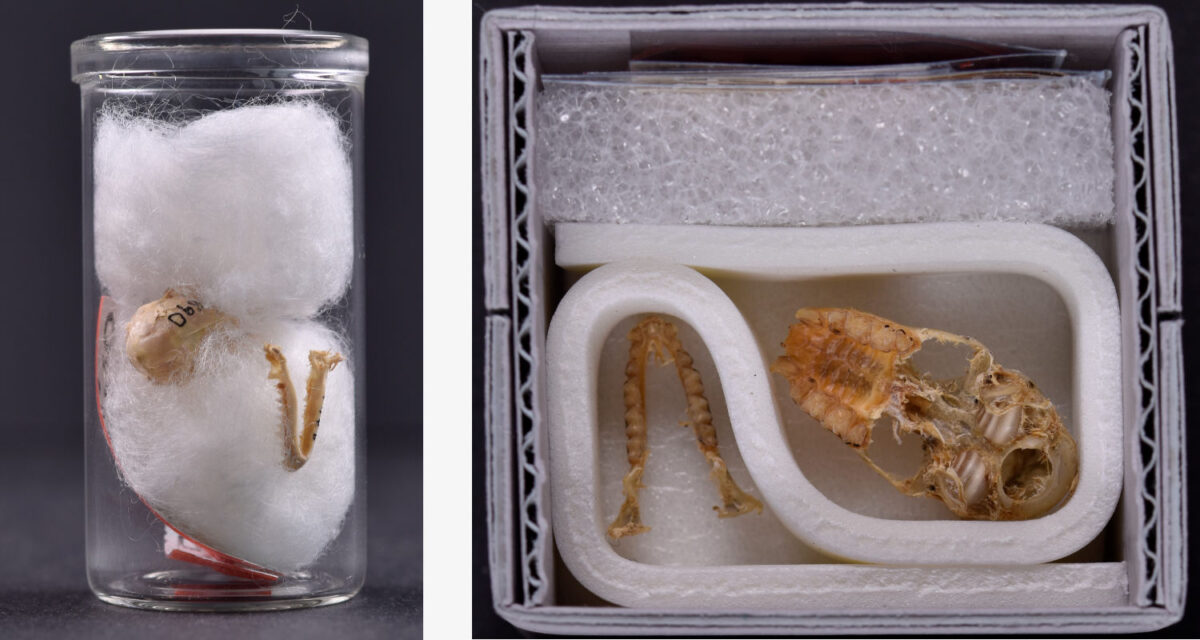
Examples (before and after) of the delicate rehousing work being undertaken for Dry Type specimens.
Collection Enhancement Project
Clare has continued to liaise with Natural Sciences collection staff for the Collection Enhancement Project. Recently she has been undertaking Fourier Transform Infrared (FTIR) Spectroscopy to build a spectral database of known reference samples and to analyse and identify samples of materials used for collection storage. This enables Collections Care and Conservation to provide recommendations about appropriate materials to use in the future for collection storage. Clare has been having discussions with the newly employed Technical Officers within the varying Natural Sciences disciplines to provide guidance about handling and supporting specimens during digitisation.
Exhibitions
Sheldon has been working with Exhibitions teams to prepare the Wild Planet gallery for the Museum reopening. Specimens required pest management treatments and reshuffling into showcases. Sheldon has also assisted in the installation of some collection items into the temporary exhibition space Tyrannosaurs: Meet the Family. Planning continues for the exhibitions program for 2021 and beyond with Robert Clendon planning for Unsettled in May 2021. Megan Dean-Jones can also begin planning for the assessment of hundreds of mineral specimens selected for the new permanent Minerals gallery.
Megan has also been focusing her attention on ensuring that material removed from exhibitions for safety reasons during the building works was reinstalled in time for opening. Megan primarily looked after the Westpac Long Gallery as well as the Surviving Australia Gallery. A series of display cases containing about 20 significant fossil skull and jaw specimens in Surviving Australia had to undergo structural and lighting upgrades. This provided Megan with a perfect window of opportunity to photograph and carry out comprehensive condition assessments on the fossils, which had never before been processed by Conservation.
Collection Care
Rehan, along with other Sydney conservators, has started an informal group centred around sharing ideas related to IPM, called ‘Warrang/Sydney IPM Group’. The group has allowed for sharing of resources and ideas with a geographic-specific approach.
The Australian Museum has upgraded its Hanwell remote environmental monitoring system. The system aims to improve reporting and analytics of storage environmental conditions. Future systems will include reporting and more detailed analytics of environment and preservation metrics.
Michael Kelly continues to condition check and document a returning loan of artefacts from the Museum’s Egyptian collection. This was a long-term loan to the University of Sydney’s former Nicholson Museum, and Macquarie University.
Conference attendance
Staff have attended several online conferences and training courses. Sheldon, Clare, and Irene attended a Taxidermy course over three virtual sessions. Clare, Sheldon, Irene, Melissa, and Robert attended the NZCCM conference. Melissa and Robert also attended the IIC conference. Clare and Irene attended the 2020 Safety and Cultural Heritage Summit and Clare attended Plastics in Peril: Focus on Conservation of Polymeric Materials in Cultural Heritage. Sheldon and Rehan attended Inclusion Culture: Empowering LGBTQIA+ public servants in NSW. Rehan, Irene and Mel attended a virtual talk by Dr Sandy O’Sullivan on ‘The Colonial Project of Gender’. Rehan has completed an online course on IPM run by Gretchen Anderson through MuseumStudy.
Australian National Maritime Museum
Social news
Jeff Fox, Luci Ronai and Nick Flood have just had their fourth anniversary at the Museum. Not that it feels like four years. It’s been great working with you all.
Staff changes
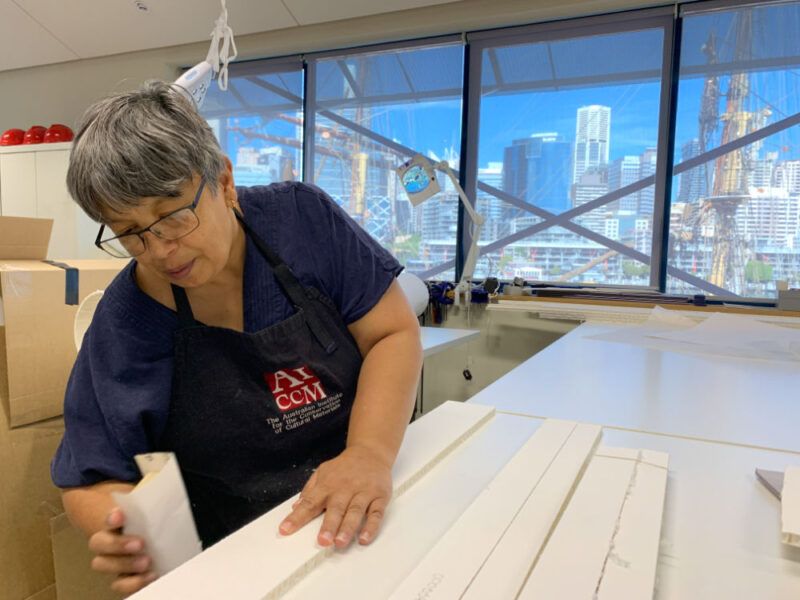
Image: Alayne Alvis joins the team. Image by L Ronai.
In October, we welcomed Alayne Alvis to the team as Senior Conservator, Exhibitions. It’s been a blessing to have Alayne arrive during such a busy time. She brings a wealth of knowledge and experience to our small team.
Events
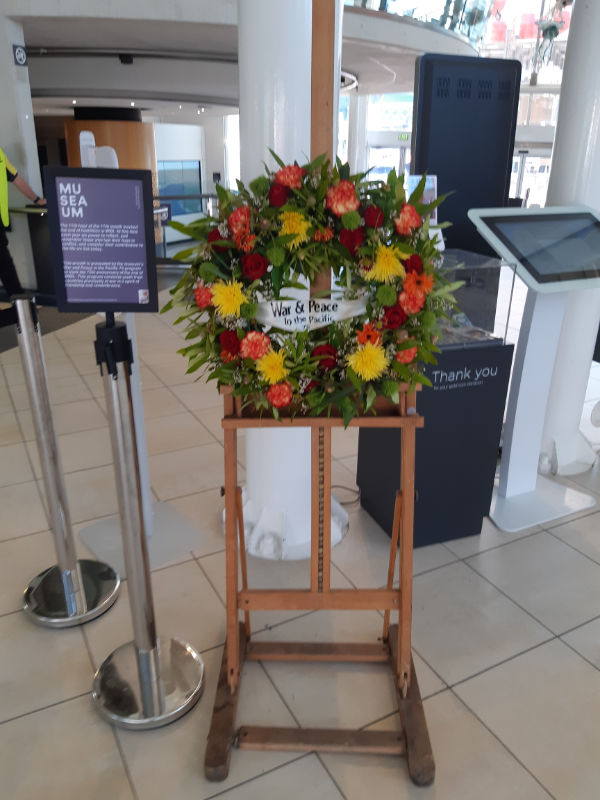
Image: ANMM commemorates the War in the Pacific. Image by N Flood.
For Remembrance Day a small commemoration ceremony was held in the Museum’s foyer. This year marks the 75th anniversary of the end of the War in the Pacific. Lest we forget.
Treatment projects
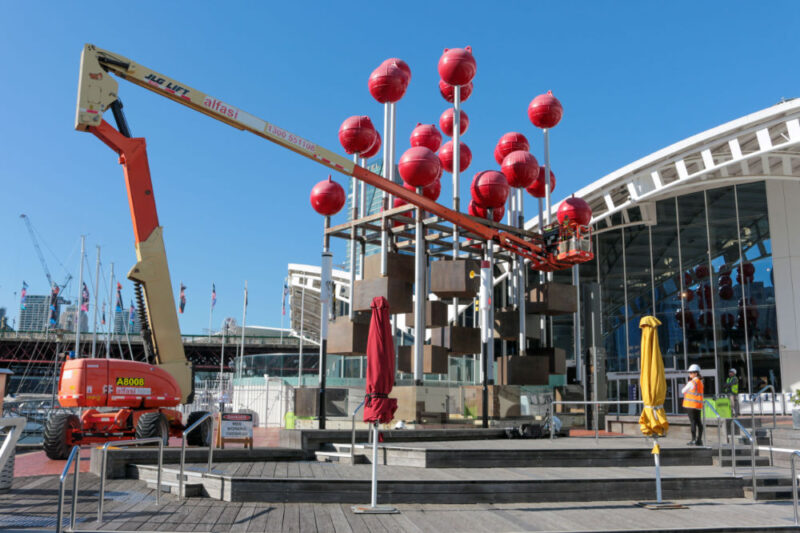
Image: Engineers assess Downward force on an upward moving object (Wang Luyan). Image by N Flood.
In November, the site-specific sculptures Upward force on a downward moving object and Downward force on an upward moving object (Wang Luyan) received their annual inspections. Engineers assessed the artworks and made recommendation for their ongoing maintenance. Minor repairs are scheduled to take place early in the new year.
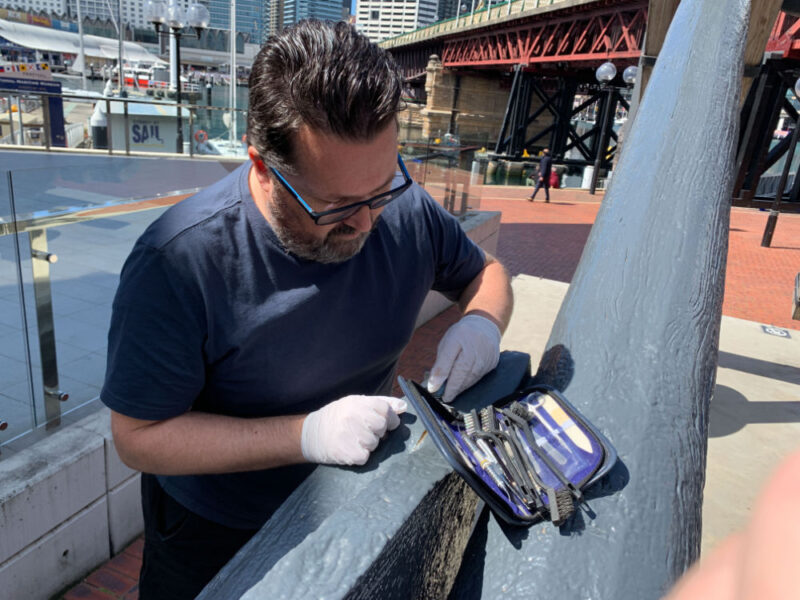
Image: Routine maintenance on the Seafarer’s Memorial by Jeff Fox. Image by L. Ronai
Jeff carried out routine maintenance on the Seafarer’s Memorial. This monument, comprising two large Admiralty-pattern mooring anchors, requires regular localised corrosion treatment and maintenance of the painted surface.
Exhibitions
Sara Freeman travelled to the museum from the NLA to deliver and install Cook’s Secret Orders into our Under Southern Skies gallery. With this loan arriving, we have removed the facsimile of the object we had standing in its place. As the months go on, with each page turn we’re looking forward to seeing more and more of the real thing.

Image: North and South (Neil Frazer) moves out of storage and onto display for the first time. Image by L. Ronai
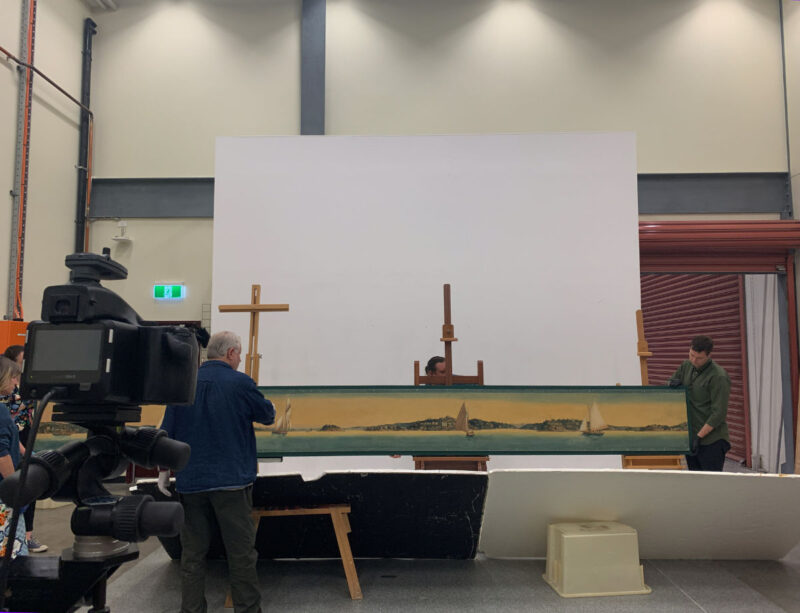
Image: Muriel Binney’s Sydney Harbour panoramic frieze in photography. Image by L Ronai.
It’s not every day that a museum gets a new gallery space. The new Sydney Harbour Gallery connects the main galleries of the Museum to the redeveloped event space on the Ben Lexcen Terrace. Nick and Luci prepared objects for display, including the huge diptych North and South (Neil Frazer) and facsimiles of the Binney frieze.
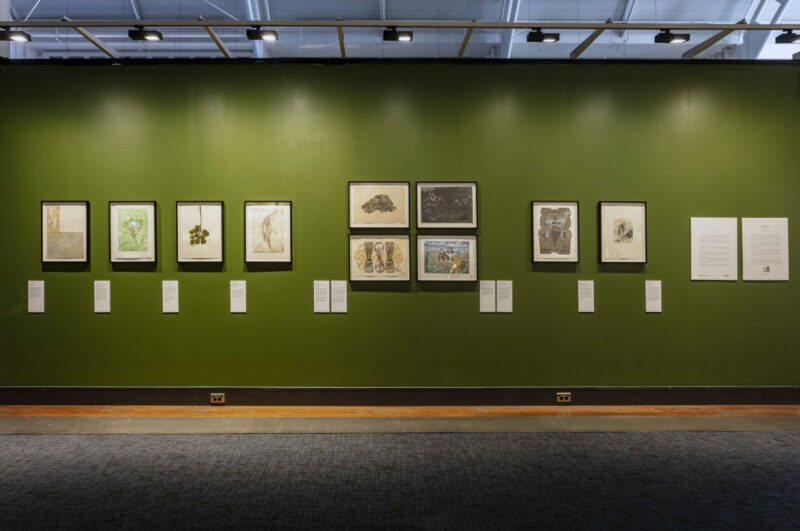
Image: Gallery view of the Paradise Lost exhibition. Image by L Ronai.
Paradise Lost: Daniel Solander’s Legacy is a touring exhibition from the Embassy of Sweden, Canberra, and the Solander Gallery, Wellington. It consists of 10 loan works on paper. While at the museum they are paired with eight Banks’ Florilegium prints from the National Maritime Collection.
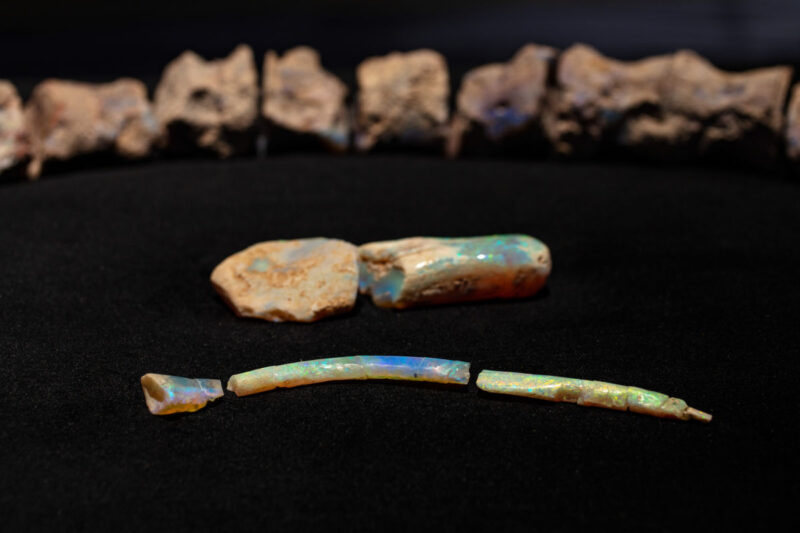
Image: Opalised plesiosaur specimens in the Sea Monsters exhibition. Image by A Frolows
Over a two-week period during the deinstallation of the Sea Monsters exhibition, Nick, Alayne and Jeff fitted out boxes and crates for the loan objects that will be journeying with this travelling exhibition. Some of this packing really challenged our grey matter. Nevertheless, we had a lot of fun finding creative solutions for difficult-to-pack objects.
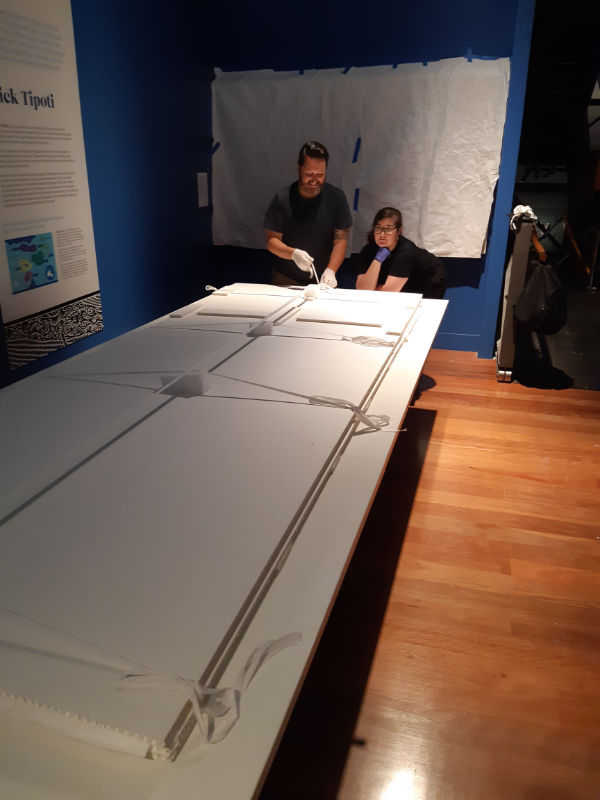
Image: Luci and Jeff at the end of a difficult installation period. Image by N Flood.
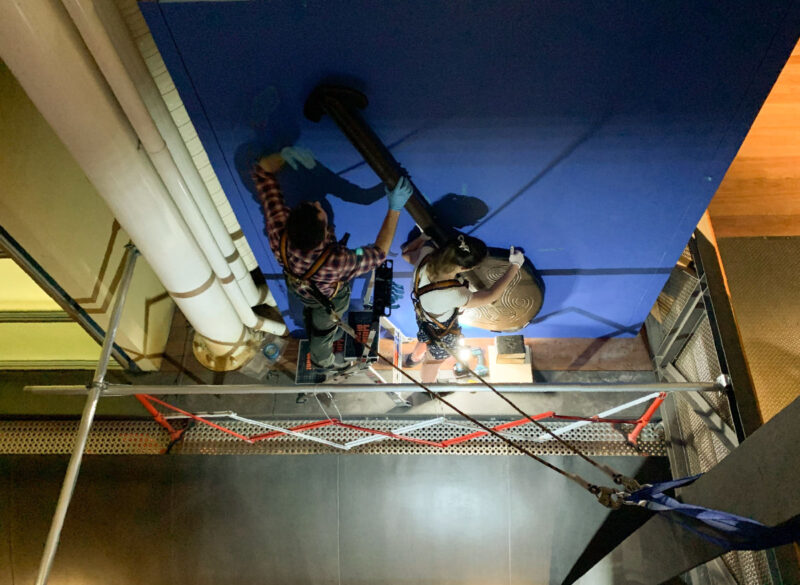
Image: Nick and Nicole Dahlberg (Exhibitions Coordinator) harnessed in to install a paddle for the Alick Tipoti exhibition. Image by L Ronai.
Mariw Minaral (Spiritual Patterns) is an exciting exhibition on the work of Torres Strait artist Alick Tipoti. Luci, Agata, Jeff and Alayne took on the heroic task of mounting and framing seven of Alick’s very large lino prints. Meanwhile, Nick prepared the exhibition’s 3D objects and even had the chance to do some ‘honest’ work, welding up several of the object supports for the show.

ANMM hosts Defying Empire, a free exhibition from the NGA. Screenshot from ANMM website.
The ANMM is hosting the NGA’s Defying Empire exhibition on the last leg of its Third National Indigenous Art Triennial tour. Tina Baum (Curator), Kathleen Worboys (Project Officer) and David Wise travelled from Canberra for the install. Having been through this process numerous times already, it was impressive to see the team from the NGA work like a well-oiled machine.
Conference or webinar attendance
A number of us in the lab donned our headphones as we worked and ‘attended’ the NZCCM Virtual Conference 2020. Congratulations to the NZCCM for a fine example of what can be achieved in these times.
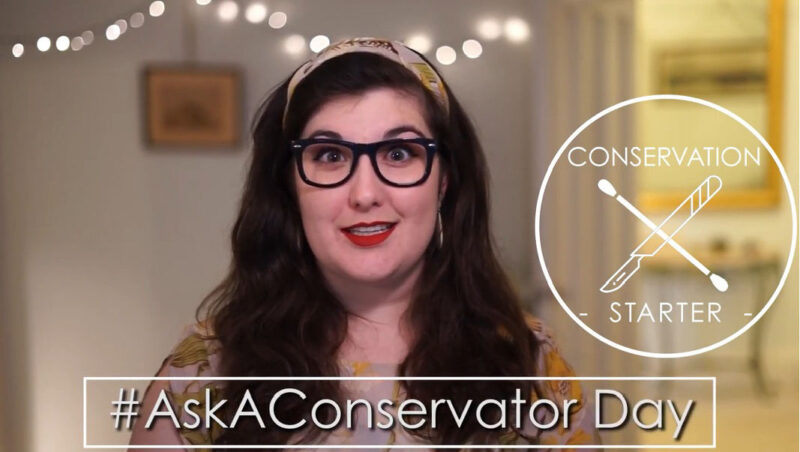
Image: Luci Ronai in her recent Conservation Starter video. Image by L Ronai.
With her most recent video about Ask a Conservator Day, https://www.youtube.com/watch?v=q5ewOcZ_JUo, Luci has recently reached the 20-video mark on her YouTube channel The Conservation Starter. Check it out here: https://www.youtube.com/channel/UC4r66EnLu8RyDfrA0kaxgrQ.
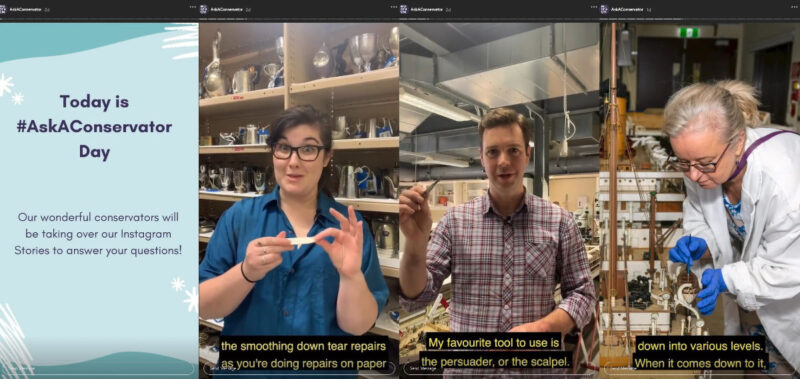
Image: Ask a Conservator Day on Instagram. Images by L Signorelli and A Frolows.
ANMM too got into the spirit of Ask a Conservator Day. The whole team contributed to the Instagram story: https://www.instagram.com/stories/highlights/17848509104395577/. Thanks to @pinknantucket and @AICCM_OZ for their Twitter questions about rusticles and shipwrecks.
Chau Chak Wing Museum (CCWM), The University of Sydney
Staff changes
After 12 years working for the Sydney University Museums, Alayne Alvis moved onto other adventures at the Australian National Maritime Museum, working within their Conservation Department. Alayne’s extensive knowledge and skills with everything conservation (and knitting!) are greatly missed!
It was sad to see Gemma Torra i Campos finish up with us in November. Visiting from Barcelona, Gemma started working with the CCWM team in February 2020. She treated many significant objects from the Nicholson, Macleay and the University Art collections leading up to the opening of the new museum. One iconic piece Gemma worked on is the LEGO replica of Pompeii now on display in the Roman Spectres exhibition.
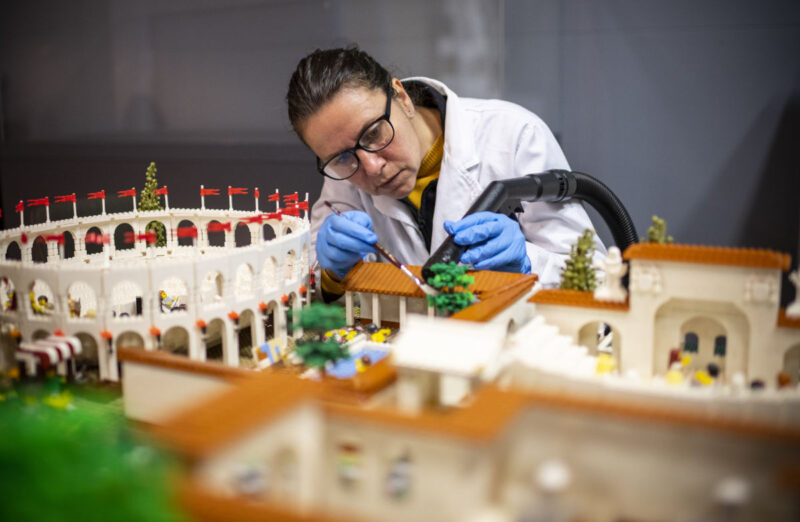
Image: Gemma Torra i Campos cleaning the LEGO Pompeii. Chau Chak Wing Museum 2020
From August to November we were lucky to have Kyra Kim and Colin MacGregor working with us in Conservation to treat a variety of objects, to install exhibitions, to conduct environmental monitoring of the new spaces and to assist in the relocation of collections.
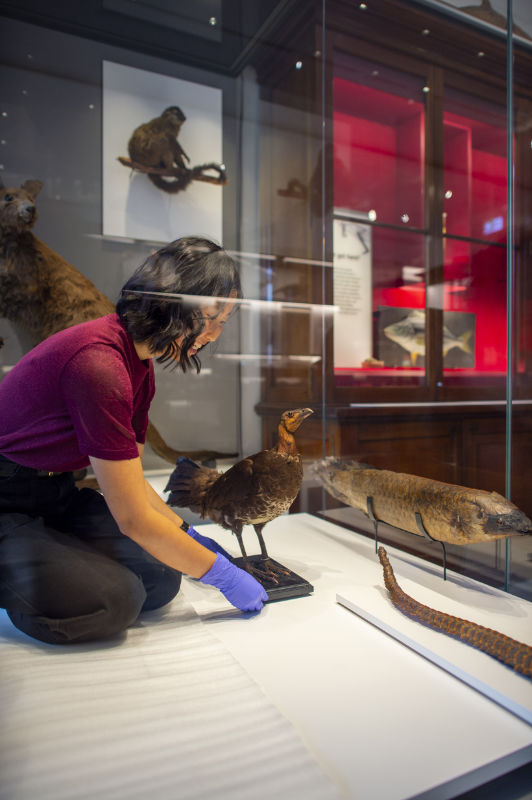
Image: Kyra Kim installing a brushturkey. Chau Chak Wing Museum 2020
Colin was on hand to treat and install collections from North East Arnhem Land as part of the new Gululu dhuwala Djalkiri: Welcome to the Yolngu Foundations exhibition. Colin also spent time treating small paintings from the Power Collection and a variety of objects for the Object/Art/Specimen exhibition.

Image: Colin MacGregor carrying out a consolidation treatment. Chau Chak Wing Museum 2020
Kyra packed scientific instruments prior to the collection relocation. She furthered her treatment skills, stabilising mounted fish specimens from the Macleay Collections prior to installation in the Natural Selections exhibition. She also cleaned and inpainted existing fills on an Egyptian sarcophagus now on display in Object/Art/Specimen. In addition, Kyra created a variety of mounts for objects from the Egyptian Collection, which are now on display in the exhibitions Pharaonic Obsessions and The Mummy Room.
Madeleine Snedden is currently acting in the role of Conservator and has been kept very very busy leading up to the opening!
Exhibitions
The Chau Chak Wing Museum at the University of Sydney opened to the public on Wednesday 18 November. Opening with 18 new exhibitions, 70 per cent of the items on display have not been seen publicly for over 20 years. The exhibitions consist of 3,500 objects on display from the Nicholson Collection of antiquities and archaeology, the Macleay Collections of natural history, ethnography, science and historic photography, and the University Art Collection.
Fox and Hinge
Off to a flying start!
Come the end of 2020, Fox & Hinge Conservation will be celebrating its first four months of operation – six months since its establishment, allowing for two months of initial set-up of physical spaces, equipment installation and lab commissioning.
With Wendi Powell as Head of Paper Conservation, Fox & Hinge is serving private, institutional and commercial clients in treating the full range of paper media, from artworks to maps, plans, books and documents, along with vellum, parchment, photographs, mixed media and three-dimensional paper-based works.
Recent weeks have seen a pleasing flow of such works through F&HC’s doors, including works by artists Norman Lindsay, William Dobell, Brett Whiteley, Russell Drysdale, Donald Friend, H Tebbitt and F McCubbin. These have found their way back to delighted owners following treatment. Pleasingly too, many of these works saw their refreshed state enhanced by framing at the hands of the team at Sophie Brown Conservation Framing, F&HC’s sister business.
The early months of operation would seem to validate the thinking behind the establishment of Fox & Hinge Conservation: as a business in its own right, filling a market niche, and as the natural adjunct to Sophie Brown’s conservation framing business.
F&HC is now up and running, with space for growth a bonus. Some of that space currently lends itself to the hosting of professional talks and presentations – events that, we hope, will further assist the development of a collective of interests centred on artworks, from their inception to their ongoing protection, preservation and management.
Early next year we will be seeking to expand the team so if you have an interest in joining us we would love to hear from you!
This year, 2020, was a challenge for all of us and in so many ways. We would like to think that 2021 will see us not only regain the COVID lost ground but break new one through the power of active collaboration. Please think of Fox & Hinge Conservation as a keen participant in any such movement with fellow professionals.
For further information, please contact:
Wendi Powell, Head of Paper Conservation,
Fox & Hinge Conservation
02 9518 6677
conservator@foxandhinge.com.au
or
Sophie Brown, Director,
Fox & Hinge Conservation
02 9518 0624
sophie@conservationframing.com.au
International Conservation Services
ICS awards
ICS is fortunate to have won a number of awards over the years for conservation projects but few have been as satisfying as winning the 2020 National Trust Heritage Award (Conservation of Interiors) for our work on the Butterfly Room at the State Theatre, Sydney.
The character lounges or retiring rooms are one of the unique features of the 1929 State Theatre being themed gender-specific ante rooms to the theatre’s bathrooms. The Butterfly Room was designed to evoke a luxurious and uniquely feminine atmosphere at the State Theatre, with exquisite butterfly murals and the butterfly theme taken up in the furniture, carpet and mirrors.
By the year 2000, no obvious traces of the original Butterfly Room murals and decorative finishes remained and the walls were finished with numerous coats of paint and wallpaper. Over two and a half years, ICS meticulously removed the later paint layers on the moulded plaster butterflies on the ceiling and carefully removed the wallpaper and later paint layers on the walls and joinery.
The project has been technically challenging, and was executed by various teams of ICS conservators as opportunities between use of the theatre occurred. Overseen by Adam Godijn, our conservators include Matteo Volonte, Eden Christian, Claire Heasman, Suati Rojas, Arek Werstak, and Jennifer O’Connell.
The project contributes to our knowledge of the appearance of rich interwar decorative schemes in an extremely important and beloved Australian theatre. The conserved Butterfly Room is now a unique window into 1929.

Image: Butterfly Room conserved panel

Image: Matteo Volonte and Jennifer O’Connell conserving the Butterfly Room.
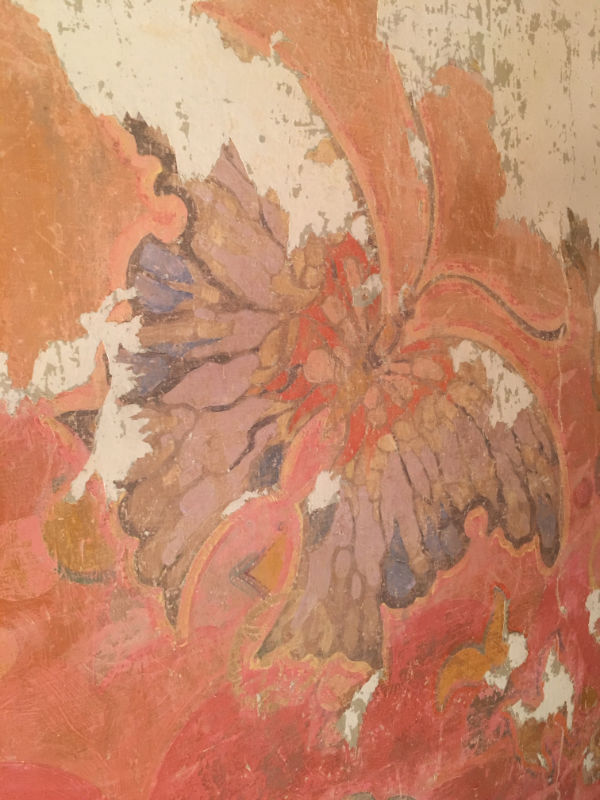
Image: The Butterfly Room during treatment.
Objects & Outdoor Heritage
Tracey Emin is famous for her confessional and autobiographical works but perhaps less known for the variety of media she works in, which includes bronze. A recent work involved placing over 60 life-size bronze birds in and around a number of buildings on Bridge St in Sydney. Earlier in 2020, ICS prepared a maintenance schedule for the artist’s studio and the City of Sydney.
Claire Rowson and Amy Walsh have just completed a round of conservation maintenance on these exquisite artworks and become very attached to them in the process.
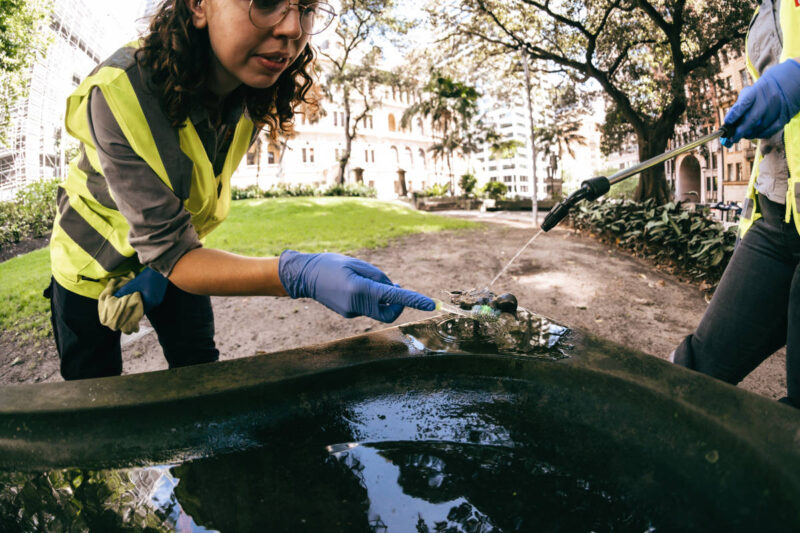
Image: Amy Walsh and Claire Rowson with Tracey Emin’s Distance of your Heart. Photo credit: City of Sydney.
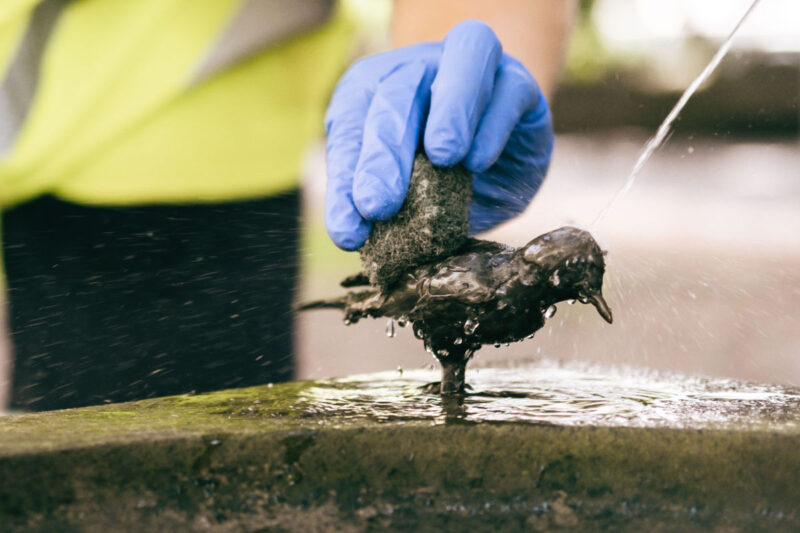
Tracey Emin, Distance of your Heart. Photo credit: City of Sydney.
The gardens of the National Trust Norman Lindsay Gallery at Springwood have an outstanding collection of original sculptures made by Norman Lindsay. The sculptures were modelled by the artist in cementitious mortars on armatures of steel bars, chicken mesh and fly-screen mesh. They have survived very well considering the materials and construction, but are beginning to need careful conservation works to their increasingly friable surfaces and structures.
ICS has been working with the NLG over many years, advising on and undertaking conservation works. The most recent of these highly fulfilling experiences was undertaken by Wendy Reade and Sergio Merida.
In November they undertook essential conservation works to four sculpture groups:
- the Woman Sitting with two female fauns
- the Squatting Satyr
- the female overlooking the pool
- the urn to the right side of the entrance path.
Fractures were grouted, exposed metal armature was stabilised, and discreet fills were undertaken to prevent water entering the body of the sculptures. All the works needed to be carefully tended during their curing period.

Image: Wendy Reade conserving Norman Lindsay Squatting Satyr.
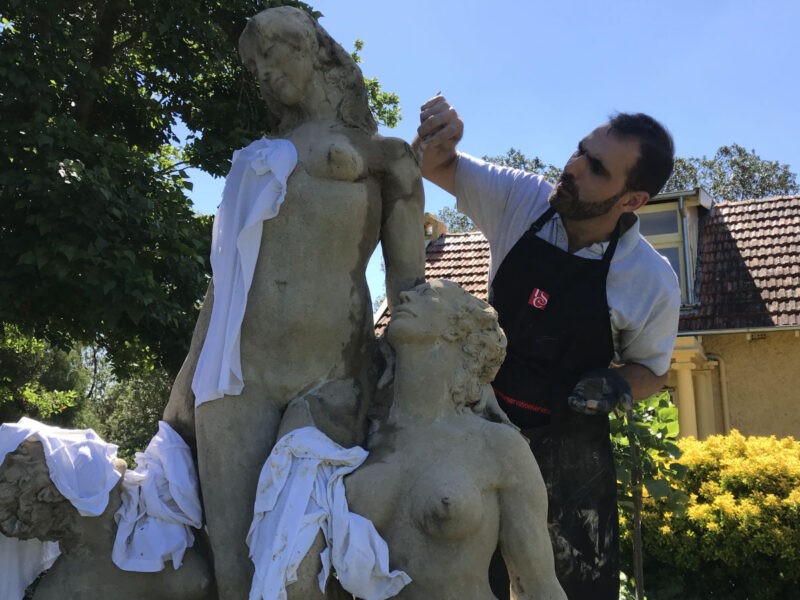
Image: Sergio Merida conserving the Norman Lindsay Woman Sitting with two female fauns.
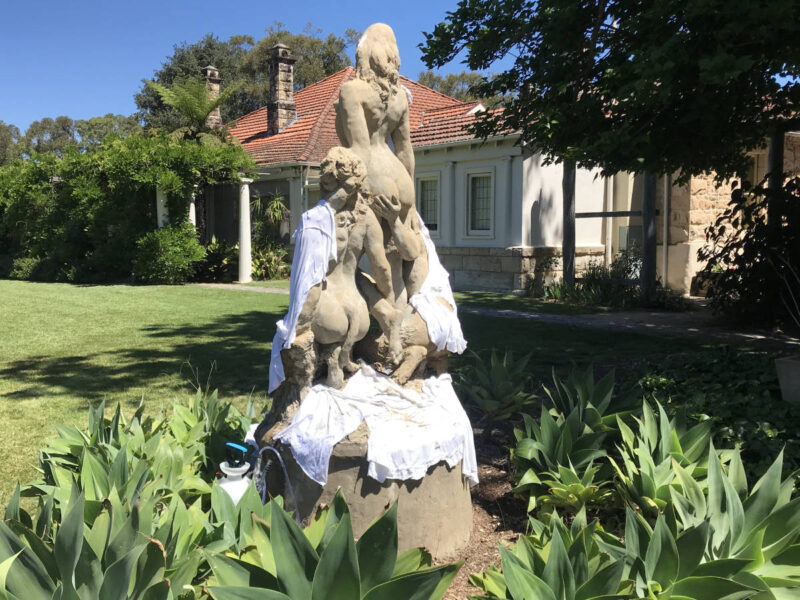
Image: Norman Lindsay Woman Sitting with two female fauns during treatment.
Museum of Applied Arts and Sciences
Staff changes
Trish Stokes has been appointed as Head of Collections. The MAAS Conservation Department will miss having Trish as Conservation Manager but are confident she will achieve great success in her new role.
Jessica Gray has been appointed as Conservation Laboratory Technical Officer. Jessica will be managing our environmental monitoring and IPM programs and assisting with the identification and management of hazardous material.
The Collections Relocation and Digitisation (CRD) project welcomes assistant conservators Danica Auld, Shubham Shrivastava, Anurati Krishnamurthy, Amy Heffernan and Jacinta Sanders. Ruth Drayson has returned from working at the State Library of NSW and Kyra Kim from working at the Chau Chak Wing Museum, University of Sydney.
Gosia Dudek has gone on long service leave but will be returning to MAAS in the new year.
Conservation scientist Sue Gatenby is retiring after 40 years in the industry. In her 27 years at MAAS Sue has undertaken numerous internal and external research projects. She would like to thank all her colleagues and friends for their support throughout her professional career.
Project and treatment update
The CRD Conservation Team has been condition reporting Category A objects, including the contents of the Governor General’s Carriage. They have also been treating a collection of Aligarh pottery and stabilising architectural plans from the Tooth & Co archive.
The CRD Hazards Team has been documenting, labelling and re-housing a collection of historic chemicals. They have also been reviewing how the Museum manages batteries and radioactive material in the collection.
The CRD Special Collections Team has completed conservation assessments on 79 archives including those of brewer Tooth & Co, Mercedes Australian Fashion Week, fashion photographer Bruno Benini, Massa Marttima , shoe company Joseph Box London, underwear design and manufacturing company Berlei Ltd, AFL’s Sydney Swans, and signwriting and graphic design studio Rousel Studios. The team has also commenced assessment of the arms and armoury collection and Speedo archive.
The Sydney Observatory is undergoing refurbishment after consultation with a heritage architect. We are planning to have artists-in-residence programs at the observatory early next year.
Plans are in the final stages for a new store at the Museum Discovery Centre, Castle Hill.
Exhibitions
Upcoming exhibitions include Shape and Student Fashion. A new transport display and an exhibition of Persian art to celebrate Persian New Year are also in the works.
Loans
This month we prepared and installed objects at the Museum of Sydney for the exhibition Paradise on Earth and at the Chau Chak Wing Museum for the exhibition China: Auspicious creatures.
Several late-notice loans are also about to open to the public with two large tapestries travelling to Artisan in Brisbane for display in Drawn Thread and a collection of photographic equipment travelling to La Perouse Museum for display in Max Dupain and La Perouse: The Caltex Story.
O’Sullivan Conservation
What a rollercoaster of a year! O’Sullivan Conservation has continued its growth strategy this quarter, with keys to new premises picked up in November. Although the space is newly constructed and has not yet been fitted out, the team is excited for the opportunity to design a custom studio. With 170 square metres of floor space, a 5-metre-high roller door, and overall height of 7.5 metres, the building offers plenty of opportunity for long-term growth and the ability to undertake large-scale projects in-house. In addition to the exciting new premises, we are keeping our existing workshop for the treatment of smaller and more delicate pieces.
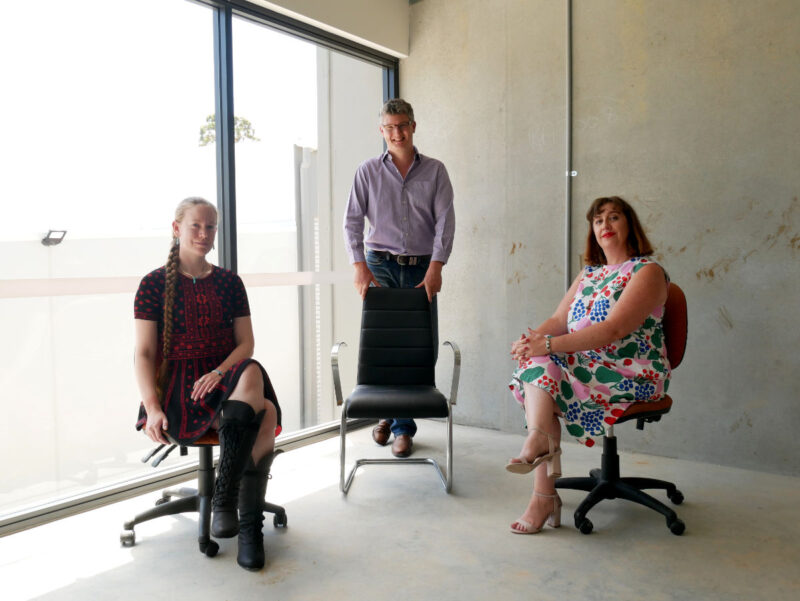
Image: The team in their new ‘office’, excited by the opportunity to argue over interior design preferences.
Professional news
We would like to take this opportunity to congratulate Hannah on her receipt of a Postgraduate High Achievers Award from the University of Newcastle. Hannah graduated with a double master’s in Business Administration and International Business earlier this year and this award recognises all the hard work she put in, achieving a distinction average in both degrees.
Additionally, Kaleigh has joined AICCM and both Eoin and Kaleigh have become members of the American Institute of Conservation (AIC), broadening their professional horizons and learning opportunities.
Treatment projects
Recent projects include the UNSW Sculpture Walk maintenance works, as well as major treatments on two sculptures, Bronwyn Oliver’s Globe and Patricia Lawrence’s Torso Turning. The conservation of two lamp pillars from the Macquarie Street frontage of Sydney Hospital, which involved recoating of the pillars and the casting of a replacement for a missing element, was undertaken in October. The pillars and associated lanterns were returned dismantled to allow for rewiring. Treatment of a collection of Asian furniture and objects on behalf of a private client was also completed this quarter. Upcoming projects include treatment of a bronze sculpture located in a pond that contains freshwater eels, a task presenting new challenges regarding access and treatment.
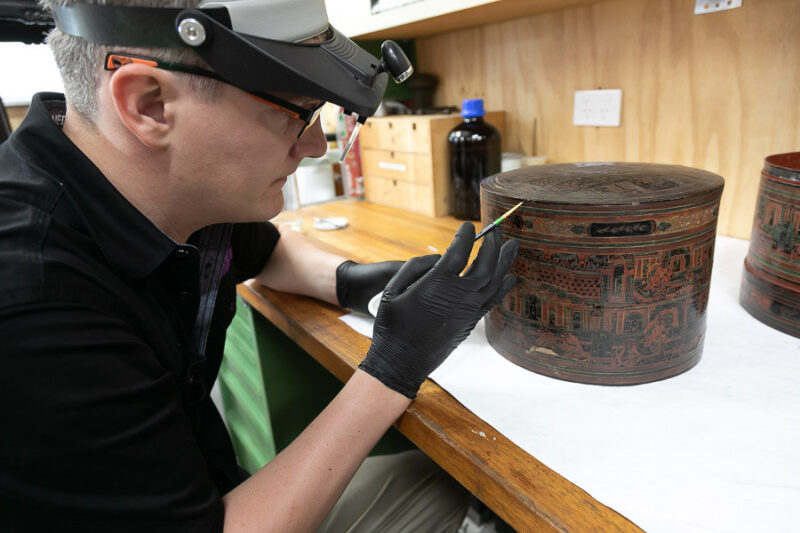
Image: Eoin inpainting a Jubako box.
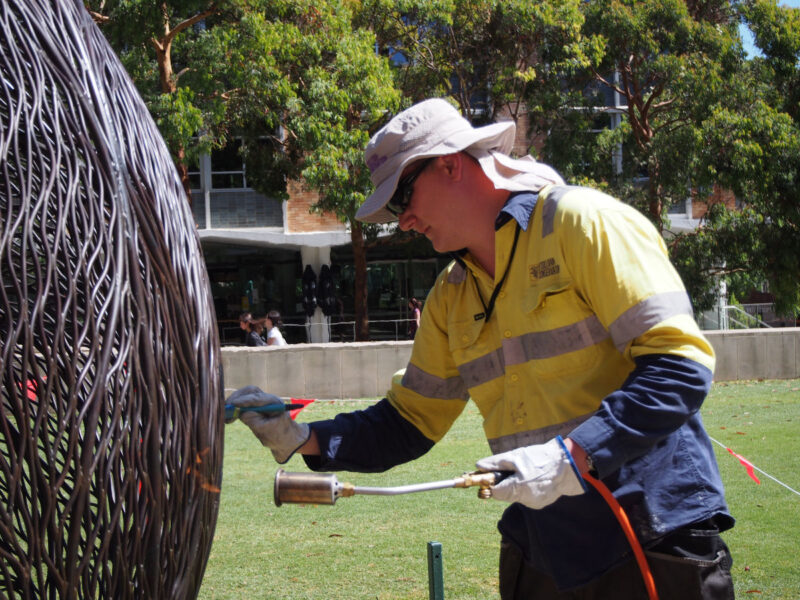
Image: Eoin reapplying wax to Globe.
Conference attendance
Hannah and Eoin both virtually attended several of the sessions of the IIC built heritage conference in Edinburgh, Scotland, in November. Eoin especially enjoyed the session ‘Mind the Shadow Gap: Reflecting on 20 Years of the Museum of Scotland and Looking Forward to the Future’, a particularly engaging topic given his history with the museum.
Preservation Australia and Conservation Resources
Having finally vacated the studio in August, it seemed fitting to provide a last update on the two businesses. Conservation Resources has essentially closed – but the archival polyester sleeves and beautiful archival presentation boxes (i.e. Solander boxes) can still be ordered. The website is being updated very soon to reflect those changes. Conservation Supplies, a new business based at Andersen’s Bindery in Sydney has taken on some of the other products previously sold by Conservation Resources.
Through Preservation Australia, Kay Söderlund is still offering preventive conservation consulting and her regular workshops, but has closed the studio and hands-on work is no longer being accepted. Most of the studio equipment went to two conservation studios (friends and colleagues) in Sydney – Tess Evans of Heights Heritage Conservation, and Wendi Powell of the new Fox and Hinge Conservation. Very happy about that!
While the bulk of Kay’s library is on loan with Fox and Hinge, she does have quite a few texts that she no longer wants to keep. At some stage (!) she will draw up a list and send it through to AICCM members, but meanwhile, if you are looking for something in particular, it may be worthwhile to contact her.
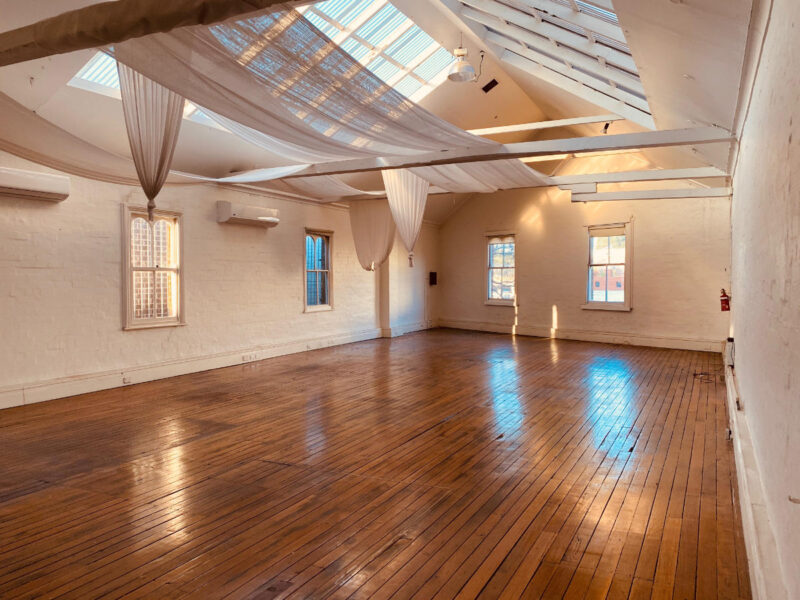
Image: PA studio – finally empty
Kay’s last major project in the studio was a simple treatment of a significant Torah from the Rare Books collection of the University of Sydney. The Torah is 22 metres long and is made up of 51 sheets of parchment sewn together and attached at either end to a wooden roller. Prior to treatment, several small samples of the parchment were taken by ANSTO to undertake radiocarbon dating, as it is thought to be one of the oldest intact Torahs in the world. Unfortunately, the testing has been delayed due to COVID-19, so results aren’t yet available. The treatment involved surface cleaning, repairing lost stitching to secure the sheets, and mending tears and holes. These repairs were carried out using three-layer caecum with gelatin mousse as the adhesive. This was a new technique for Kay, who is indebted to Libby Melzer from Grimwade Conservation Services for all her advice, assistance and supply of the appropriate gelatin. Libby was very generous with her advice, even hosting a Zoom webinar for those in Sydney interested in the technique.
For Kay, it was lovely to have this as her last major project, not only because of the nature of the object, but mainly due to the fun of learning a new technique at the end of her hands-on career.
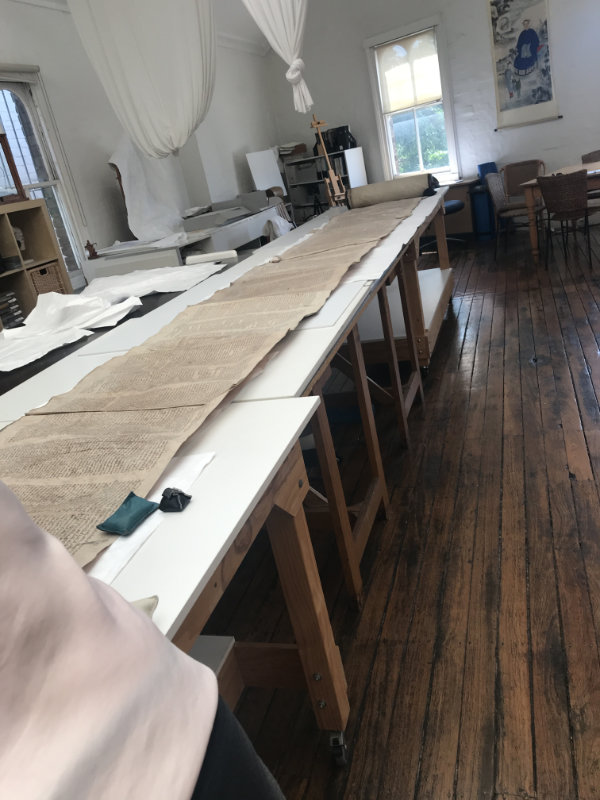
Image: : Not even half of the Torah!
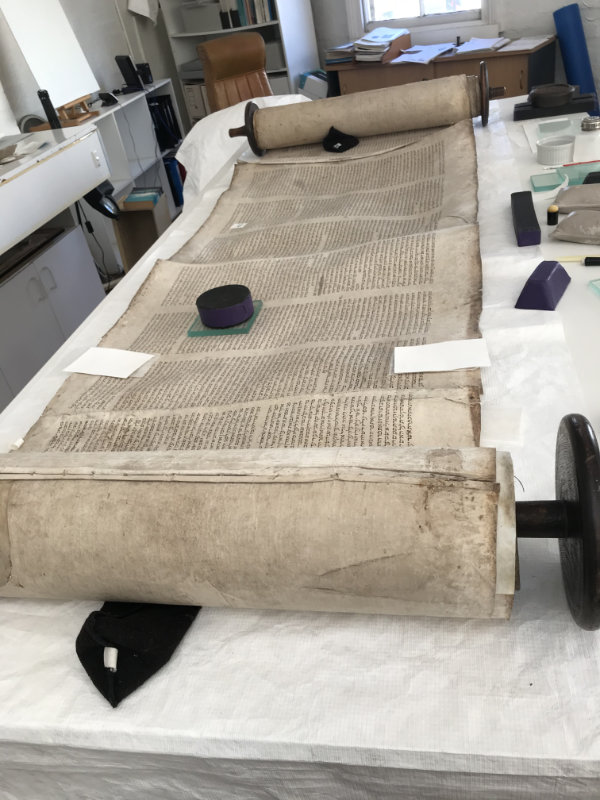
Image: Torah during treatment.
She also had a lovely well-attended (as much as COVID could allow) farewell morning tea at the studio, with some reminiscing amongst friends and colleagues about the years they have all known each other. Conservation is such a special profession to allow these relationships to develop and strengthen throughout our careers. And there was a LOT of cake!
While Kay may have retired, she is still intending to remain actively involved in the profession, particularly through being the AICCM representative on Blue Shield Australia.
State Library of NSW
Professional news
Exhibition and Loans Team
Helen Casey is researching historical navigational instruments to inform treatment and display in the new SLNSW Maps Room and in our upcoming 2021 exhibition Mapping the Pacific. Cath Bartley has been working on preparing nearly 200 items for display in the Library’s new exhibition, Coming Out in the 70s. It has been a challenging design layout to fit all items into a single gallery space. Helen and Cath are also preparing to take down four large portrait paintings on long-term loan to Parliament House, Sydney. The paintings have been on loan since 1985 and will come back to the Library temporarily to be digitised for the first time. Helen and Cath both enjoyed the online IMF2020 conference – an excellent resource for new ideas for displaying collection items. Private conservator Michelle Wassell took on a very tricky varnish removal for a newly acquired Herbert Badham painting, Hazy Morning, 1944. Michelle’s treatment has transformed the very discoloured painting, which will soon return to the Library for display on the new acquisitions wall in the Paintings galleries in time for the holiday season. David Butler has made a 1940’s-style frame for the work to complement the new look of the painting. David has also completed a fourth frame in the style of colonial frame-maker Solomon Lewis for a painting by Maurice Felton as part of the Library’s privately sponsored Felton Framing Project – it will also go on display in the Paintings galleries.
Preservation Team
The Preservation Team has been helping out our Exhibitions and Loans colleagues, with work on Coming Out in the 70s, opened 28 November. This has a wide variety of items with a range of different display requirements. We cut Softlon circles to hold badges, placed magnets in t-shirt-shaped mountboard to display protest shirts, and constructed a variety of book supports using our new favourite lavender mount board. We have also assisted in preparing items for the new Maps Gallery to open next month. As well as mounting and framing original historic maps, we have prepared mounts for high-quality prints of subdivision plans from around Sydney, constructed shelving inserts for books to be displayed in bookcases, and placed maps in Mylar sleeves to enable readers to view them in display drawers. On top of all this, new collections keep coming in at a rate of knots, keeping us busy in the quarantine room, checking boxes, freezing and cleaning out boxes and tubs of assorted archives.
Digitisation (DEP)
The Collection Care Digital Excellence Program (DEP) team has been busy assessing county plans for treatment and to send to offsite digitisation. The plans are of the original 19 counties of NSW and range from small hand-drawn iron gall ink sketches to printed lithographs. Some are in very poor condition and require considerable treatment before digitisation. The team has also been connecting to colleagues working from home (including overseas) with weekly endband practical tutorials. Below are examples of endbands created by the ‘Endbandits’ group. They include Islamic style endbands—the Southeast Asian chevron and chessboard-pattern endband—as described by Karin Scheper’s article ‘Endband varieties in the Islamic world’, and Coptic headband and plain wound double headband, as described in Greenfield and Hille’s ‘Headbands: How to work them’.
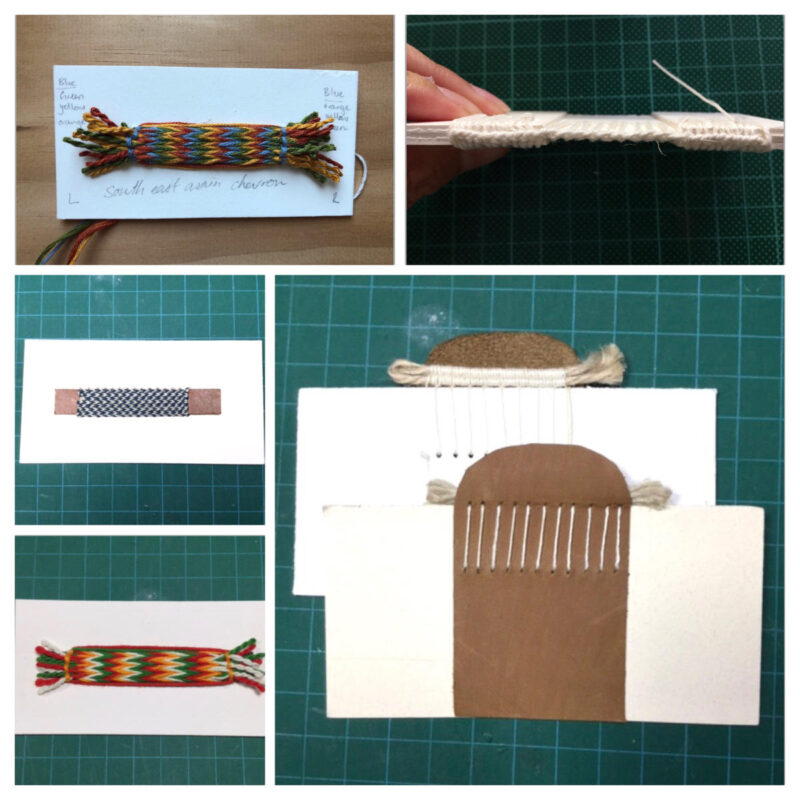
Images: Examples of endbands made by the ‘Endbandits’. Top left and bottom left: Southeast Asian chevron endband. Mid left: chessboard-pattern endband. Top right: Coptic headband. Bottom right: plain wound double headband. Images collated by Hoa Huynh.
Kiki Lawler-Dormer and Hoa Huynh have completed recordings of lightning talks for the upcoming virtual 2020 Conference and Annual Meeting of the Australasian Consortium of Humanities Research Centres (ACHRC), hosted by the State Library on 2–4 December. In these talks, Kiki and Hoa discuss the workflow cycle of the Motion Picture Film Preservation Project, and potential research outcomes with digitised images of Aboriginal petroglyphs from William Dugald Campbell’s Aboriginal carvings, Port Jackson and Broken Bay, 1893–1896.
Paper and Photographs Team
The Paper and Photographs Team has been busy on-site since June, completing works for the upcoming Maps Room installation. There are 28 maps to be installed and although some have had minor treatment, others such as a 1781 reprinting of an Albrecht Dürer map of the world have been interesting treatments for Cecilia Harvey. Like many of the Library’s map collection, the Dürer map had been fully mounted to a canvas backing with animal glue, probably during the 1950s. Upon removing the canvas backing, which was distorting the map, Cecilia revealed hidden inscriptions and also the watermark IAV-WOLFEG from a German paper mill of the late 18th century. After washing and repair, the work has been pressed, mounted and framed ready for the Maps Room opening in January 2021.
The team has also commenced the survey of over 550 miniatures in the collection. These items are enormously diverse, from early cased photographs and tintypes to miniatures on ivory and paper. The team of Nichola Parshall, Kate Hughes and Wendy Richards aims to look at condition and to prioritise items for treatment, as well as digitisation and housing of the collection. This work has also given the team the opportunity to examine the additional notes and information often stored with the objects, including one from 1951 that noted that the miniature was repaired with Tarzan’s Grip adhesive in that year!
In preparation for the exhibition Coming out in the 70s conservators Trish Leen and Kate Hughes were faced with the challenge of consolidating silver glitter onto a matt fluorescent pink screenprint. Discreet testing of adhesives was done to ensure the consolidant would not affect the surface reflectance of the fluorescent ink or glitter. Bermacoll was the perfect match and the poster has been returned to its sparkling glory.

Images of glittered screenprint item in its sparkly glory after consolidation. Images: Kate Hughes.
Dana Kahabka has formulated a useful range of concentrated polymer solutions from hydroxypropyl cellulose (HPC) in ethanol, into their entangled state, with the aim of removing an aged triterpenoid varnish from a paper-based 17th-century Dutch map, Bonaparte Tasman Map. The dissolution of the glossy varnish was achieved by impeding the flow of solvent from the viscous HPC solution into the varnish with applications of 7wt% to 10wt% of HPC (1,000,000 molecular weight) through a barrier layer of porous abaca tissue. Approximately 70 per cent of the glossy varnish has been successfully removed.
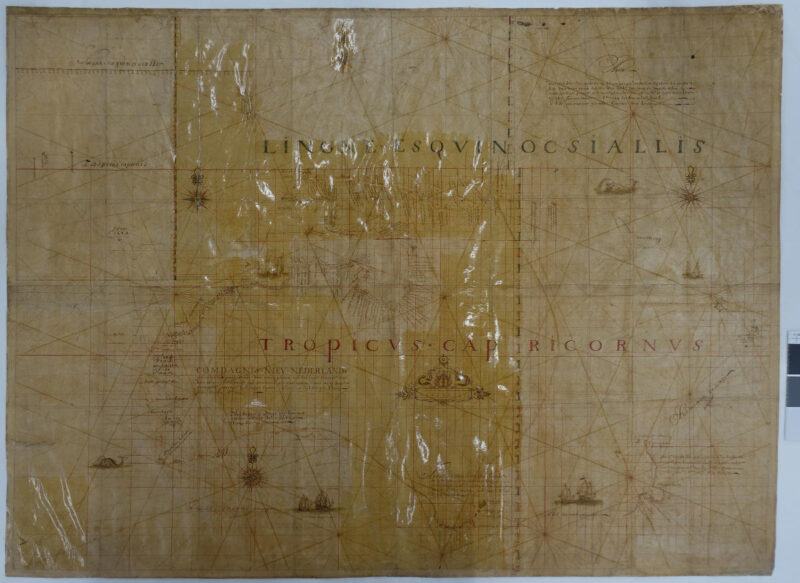
Image: Bonaparte Tasman Map during treatment with 70 per cent of varnish reduced. Image: Dana Kahabka.
Book, Objects and Paintings Team
The BOP Team has been supporting the Library’s resumed exhibition program, making book cradles and treating items for display for interstate and in-house exhibitions (Pandemic, the Maps Room and New Acquisitions), as well as continuing minor repairs on our rare books collection. The rare book survey, put on hold during the shutdown, is recommencing, with the team also undertaking some rehousing of volumes identified as being in need during the earlier completed portions of the survey.
Collection Care Conservation Labs update
The SLNSW conservation labs were last refurbished in the 1980s and since then significant changes in work practices and space requirements have occurred. The Branch has grown while the accommodation has shrunk. The role of the Branch within SLNSW has also evolved, and we have been required to relocate some functions due to building refurbishment, which has meant that spaces are being used for functions for which they were not designed. In addition, over the past two years, new exhibition galleries have doubled the exhibition space of the Library. This in turn has placed greater demands on conservation spaces already stretched to capacity.
In 2019, after some years of false starts and funding issues, we secured donor funding to support the provision of new and larger conservation labs. Since May 2020, there has been a frenzy of demolition and building work converting an old library stack and office spaces into our new facilities.
For the first time, the Ainsworth Conservation Laboratories (official name) will accommodate all the conservators in one location in larger and dedicated spaces for specialist conservation work. The new laboratories will support Foundation events and enable the Library to schedule educational tours for the public to showcase in-house conservation expertise.
The suite of spaces consists of three labs, a photographic/analytical room, an admin area, a secure room for collection items awaiting work, and storage rooms for materials and equipment. The two main spaces, Lab 1 and Lab 2, will provide increased space for all conservation activities. In addition, we will have a dedicated laboratory for conservation treatments requiring the use of specialist solvents, as well as a separate space to undertake treatment photography and analysis of collection items using microscopy and XRF. The increased space for aqueous treatments allows for improved handling and treatment.
Associated with the new labs will be the subsequent refurbishment of the existing Domain Lab and the Shakespeare Lab. The Domain Lab will be refurbished to house large equipment (moved from the back-of-house area) as well as some materials storage. It is envisaged that framing, collection housing, boxing, box-making and mount-cutting will have dedicated space in the Domain Lab along with occasional conservation treatment work, and the Shakespeare Lab will become a quarantine space for screening, documentation and housing of incoming acquisitions prior to storage. Our existing quarantine space is temporary and inadequate.
Overall, the space for the Collection Care Branch has increased from 517sqm in the existing spaces to approximately 705sqm.
With luck, by the time you read this the build will be complete. We plan on moving into the labs at the end of Jan 2021 and we promise some photos in the next newsletter.
Northern Territory
Museum and Art Gallery of the Northern Territory
Exhibitions
Conservation, with assistance from the Exhibitions team, has just spent three weeks condition checking and packing the moment eternal: Nyapanyapa Yunupiŋu, https://www.magnt.net.au/nyapanyapa, a survey exhibition produced by MAGNT, with generous support from the the Buku-Larrŋgay Mulka Centre, and Roselyn Oxley9 Gallery. Nyapanyapa is an important female artist who works in the remote community of Yirrkala in north-east Arnhem Land. This exhibition celebrates her as an artist displaying her bark paintings, larrakitj, hibiscus wood sculptures, prints, digital projections and a large painting installation.
MAGNT produced regarding the conservation of Nyapanyapa’s bark painting Lines
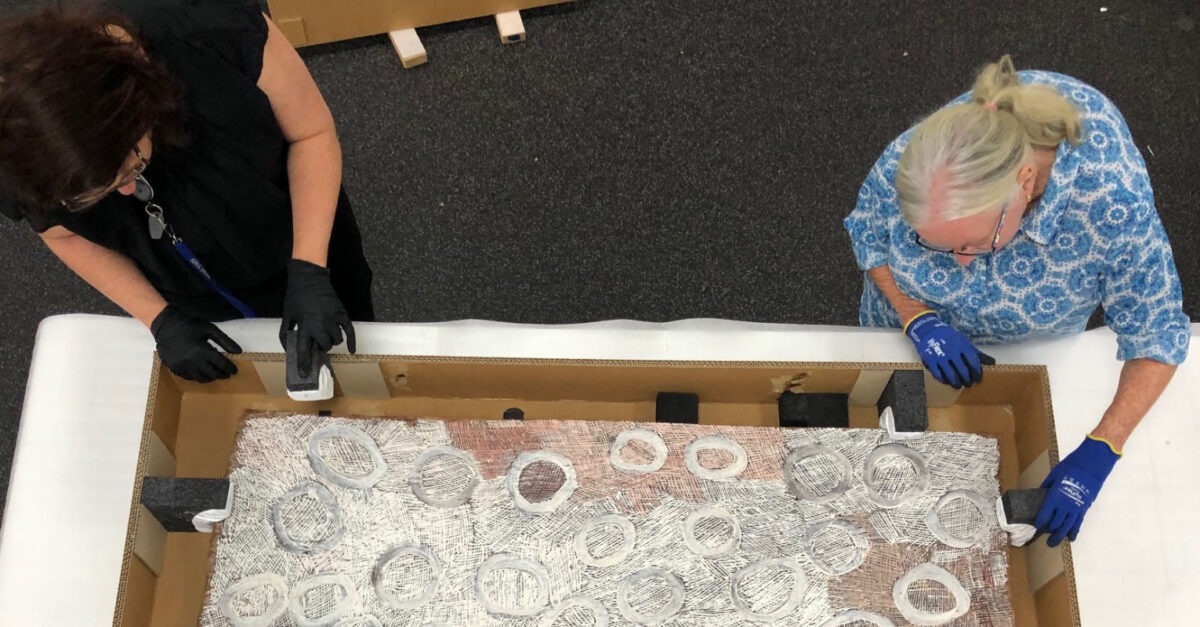
Image of Lisa Nolan and Paula Chappell repacking one of Nyapanyapa Yunupiŋu’s bark (Eucalyptus tetrodonta) paintings to be returned to an interstate lender. Notice the padded brackets are being supported in a fixed position to prevent abrasion to the painting’s surface and movement during transportation.

Image of Fiona Bennie and Sandra Yee refitting the final bark-painting box.

Image: Nyapanyapa Yunupiŋu visited MAGNT in October with her sisters to view and celebrate her survey exhibition. The exhibition was postponed by one month due to COVID-19 and reopened on 23 May until 25 October. Image: courtesy Charley Bliss.
While Telstra NATSIAA 37 is on display in two galleries until 31 January 2021, our two conservators continue to prepare Fresh: Connecting New and Old Art, which will open next year on 23 January. See the virtual gallery and winners here: https://www.magnt.net.au/natsiaa
Storage review
A Preventive Needs Assessment (PNA) for the Aboriginal Store was carried out by Catherine Millikan Conservation Services. The PNA report has been finalised and important conservation recommendations for the Aboriginal collection have begun to shape how the store is being maintained and the collection cared for.
Loans
Three works were prepared for inclusion in Bitumen & Dirt – Wayne Eager: 30 years in the Territory. The exhibition is on at the Charles Darwin University Art Gallery until 20 February 2021 and will then tour with Artback NT to Araluen Arts Centre in Alice Springs.
Loans were also prepared for Parliament House with the newly appointed Minister for Arts, Culture and Heritage, Hon Chanston Paech. The Arts portfolio now sits within the NTG Department of Territory Families, Housing and Communities.
Professional development
Sandra Yee headed to Canberra in November for a workshop on Paper Conservation and an Introduction to Photographic Conservation.
Podcast
A podcast series ‘The Collection’ created by Story Projects with funding from National Science Week Northern Territory takes listeners back of house at MAGNT. Episode 4 ‘Surviving a Cyclone’ features Conservator Lisa Nolan. Listen to all episodes here: https://www.magnt.net.au/thecollection
Social news
Congratulations to Eliana Urrutia-Bernard, Assistant Conservator, and her partner, Ryan, on the birth of their beautiful baby girl in July. Ellie will return from leave in March 2021.
Queensland
Queensland Art Gallery / Gallery of Modern Art (QAGOMA)
Paper Conservation
During the public closure of QAGOMA earlier this year due to COVID-19, it was possible for Samantha Shellard, Laura Daenke and David Rousell to continue working towards the opening of Unfinished Business: The Art of Gordon Bennett, which was rescheduled to 7 November. This display draws heavily on works from the Bennett Estate and is representative of his multi-disciplinary practice showing a vast array of works on paper previously not seen together, including pastels, photographs, watercolours, acrylic paintings on paper, felt-tip pen drawings and ink-jet prints. All of these artworks were condition assessed, mounted and framed in preparation for the exhibition. Treatments involved separating acrylic painted surfaces from Mylar sleeves, removing mould growth from photographs and reframing multi-panelled artworks.
Another exhibition that the Paper team is currently mid-way through preparing is William Yang: Seeing and Being Seen, which has been rescheduled to March 2021. This is a major retrospective showcasing over 250 images including Yang’s large landscapes as well as renowned social documentation. This exhibition has been a fantastic opportunity to work closely with the artist and discuss his practice of several decades.
One of QAGOMA’s recent major acquisitions via the Gallery Foundation has been a suite of 12 oversized smoke and charcoal poker images and large bronze sculpture by artist Lindy Lee. Mount Cutting Technician David Rousell has already completed several custom-made boxes for these images. Samantha Shellard and Laura Daenke have begun devising an innovative mounting method using full-scale mock-ups in order the display this suite of works in June 2021.

David Rousell and Laura Daenke preparing custom-made boxes for the Lindy Lee oversized works.
In a recent display of Albrecht Dürer prints, Kim Barrett was able to work with both gallery design and installation teams to provide distinctive illumination of these works with a significantly reduced lighting level (25–30 lux) while still maintaining optimum visitor experience. Similar results were achieved to extend the display time of a cased daguerreotype in the International Galleries by consultation with the design, workshop and installation teams to develop an innovative case design and mount and clever lighting to give viewers a truly positive experience.
Kim is immersed in all things light at the moment, currently undertaking some concentrated research of developments, current practices, introduction of LED lighting and what it means in regards to current lighting practices and policies at QAGOMA.
Sculpture Conservation
Catherine Collyer, Elizabeth Thompson, Caro Toledo, Liz Wild and Amanda Pagliarino from the Sculpture team have been kept very busy preparing more than 100 motorbikes for QAGOMA’s exhibition The Motorcycle: Design, Art, Desire, which opens on 28 November. The exhibition showcases many iconic and influential motorcycles from the 1860s to the present day, including electric motorcycles. The team of conservators has condition assessed, photographed and cleaned the motorbikes, each choosing their favourites to work on. The motorbikes range from original condition with entire surfaces corroded, to others that have been meticulously and beautifully restored, as well as pristine new bikes. The Sculpture team has also worked closely with the Workshop team to devise complex custom-made mounts for the motorbikes.
Collections Online Project
The Collection Online team is busily photographing extra-large paintings in one building, and powering through bulk photography of smaller works on paper from map cabinets in the other. We are aiming to photograph an average of 50 items a week to complete the entire collection in a three-year period. Conservators are taking the opportunity to do a condition check and identify any re-housing requirements while works are out of storage. In planning for upcoming photography of large installations and sculptures, we are ‘sleuthing’ through old files and archives to determine installation requirements for some early works that haven’t been installed in decades. Searching through hardcopy files for transparencies, slides, handwritten artist’s notes, exhibition catalogues and early install plans is proving to be very rewarding. The project is highlighting the importance of maintaining detailed installation manuals, and documenting iterations and artist’s intent, to avoid the very real threat of dissociation. The Collection Online Project is thus bringing together new photography and old files, to better conserve the QAGOMA collection.
Conservation Frames and Furniture Studio (CFFS)
The CFFS has been a hive of activity over the past few months. Alex Forrest has constructed the third oversized stretcher for Mirdidingkingathi Juwarnda Sally Gabori’s Makarrki (2008). You can read about the construction of these stretchers in Alex’s article for QAGOMA’s Artlines (issue 2/3 2020, pp. 62–63). Alex has also been busy preparing 56 standard works on paper frames for the William Yang exhibition opening at QAG in March 2021.
Robert Zilli has produced a suite of 11 replica 16th-century German frames for Albrecht Dürer works on paper, currently on display in the International Art galleries at QAG. This project has gained the interest of QAGOMA’s Marketing, Advertising & Digital team who are preparing a short video on the Dürer frames.
Damian Buckley is progressing well with the major restoration treatment of the frame for Henry Short’s Fruit and flowers, 1859. Damian is in the process of reintegrating gesso losses and producing casts of missing ornament.
The CFFS team has also been undertaking online classes on traditional water gilding hosted by Charles Douglas Gilding Studio in Seattle.
Paintings
It was all hands on deck for the installation of Unfinished Business: The Art of Gordon Bennett. The retrospective exhibition showcases almost 200 works among which are more than 60 paintings, including some of Bennett’s (1955–2014) most important and admired works. You can read more about Bennett’s practice and enduring legacy on the QAGOMA website here: https://blog.qagoma.qld.gov.au/tag/gordon-bennett/.
The exhibition marked the end of the major collaborative treatment of Bennett’s Number Three (2004) – a termite-damaged acrylic painting, which first arrived at the conservation lab from the artist’s estate almost a year ago. Collapsed stretcher members, gaping holes in the painted canvas and metres of resistant mud deposited on the front and back surfaces all required attention. The Paintings team spent many months experimenting with different materials and techniques for use. Stay tuned for Madeleine Ewing’s blog post about the innovative treatment solutions they developed.
Emily Kelleher has been busy devising complex hanging systems for display, fitting works into handling frames for safe travel and storage, condition assessing new acquisitions and undertaking minor treatment of works in preparation for loan and display.
Anne Carter has been working with Madeleine, Emily and Alex Forrest to stretch the abovementioned Gabori painting Makarrki (2008), measuring 2 x 4.5m. This is the third large stretcher Alex has made for Gabori paintings this year and we were all very excited that the stretching went without any hitches and the stretcher fitted perfectly. The painting had arrived rolled face-in on a small diameter tube and Anne and Madeleine spent time humidifying out creases prior to stretching.

Image: Alex Forrest and Emily Kelleher assemble the oversized stretcher.
Gillian Osmond and Anne continue their work with Paula Dredge on text for an upcoming Sidney Nolan exhibition catalogue. Anne is enjoying spending time in the John Oxley and Fryer library archives checking primary sources.
We have also produced a three-part blog series on one of QAGOMA’s most beloved paintings by R Godfrey Rivers, Under the Jacaranda (1903) – based on paint cross-sections prepared by former Senior Conservator John Hook and timed to be published during the October purple Jacaranda season in Brisbane: https://blog.qagoma.qld.gov.au/what-is-under-the-jacaranda-the-colour-purple-australia/.
In between other loans and exhibitions, we have also managed to upgrade the software on our Bruker Tracer 5i, and may even manage to work with Artax software, which we have been having trouble enabling.
South Australia
Artlab Australia
Treatment projects
Objects lab
Emily
Emily is a carved alabaster figure restraining her dress in high wind. She is reported to have been created in the 1930s by an unknown artist. Alabaster is a relatively soft stone with beautiful translucency and colour variation. Its softness and porosity mean that alabaster is sensitive to heat and prone to discolouration. While Emily had not suffered from discolouration, she arrived at Artlab broken off her base.
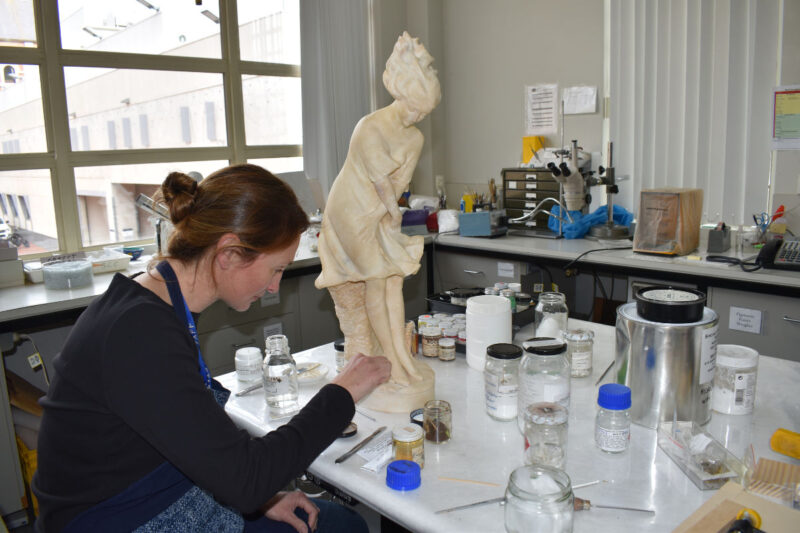
Image: >Emily in the objects lab during treatment.
Earlier attempts at repair had left encrusted, discoloured adhesive on the surfaces of the break. She was also grimy and dusty.

Image: Before treatment – encrusted adhesive from earlier repairs.
Treatment started with mechanical removal of the old adhesive and no lasting stains had occurred. The break was adhered with conservation grade epoxy. Losses were filled with epoxy mixed with dry pigments.
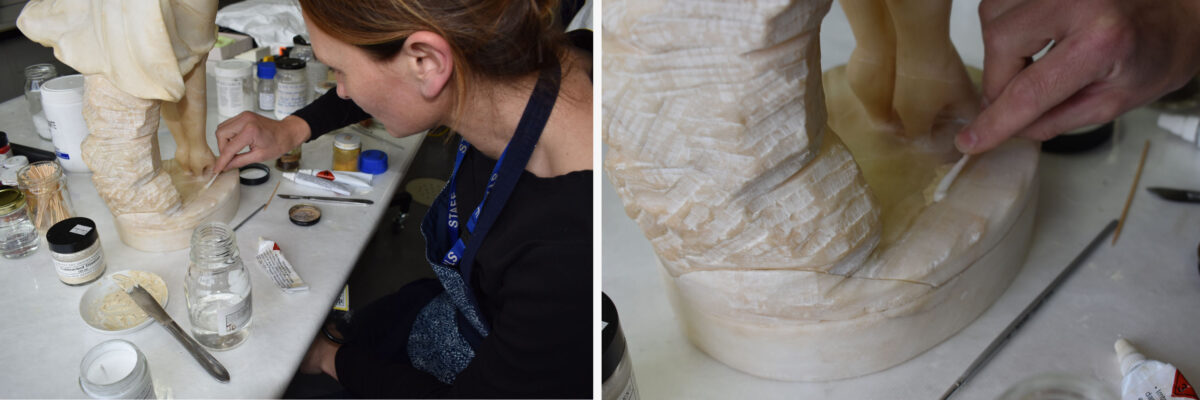
Images: During treatment – infilling.
The sculpture was now well balanced and did not require dowelling or further reinforcement. After a light brush vacuum, all surfaces were swab-cleaned with a solution of deionised water and white spirits (50:50) with a couple of drops of surfactant (Teric N9).
Once a good overall clean was achieved the surface was waxed with clear microcrystalline wax then buffed to a gentle sheen with a soft cotton cloth. The wax coating emphasised the colour and veins in the stone, particularly on the hands and folds of fabric.

Image: During treatment.
As we packed Emily into her car the client told me she would display Emily inside on a plinth in future, out of reach of grandchildren, dogs, and the cleaner.
Projects Lab
A Day Out by Marguerite Derricourt
A Day Out is a sculpture installation by artist Marguerite Derricourt of four cast bronze pigs and a customised rubbish bin with cast bronze rubbish to the top.
The sculpture is located in a prominent position in the busy pedestrianised precinct of Rundle Mall, in the city centre of Adelaide. The pigs are open to public interaction, with children and adults regularly seen riding, patting and posing for photos on their visit to the Mall. Unfortunately, at some point in the early morning of 23 September 2020 the pigs were vandalised by the application of a corrosive substance to their surfaces. The substance was applied as splatters and more legible written words to the eyes, back and flanks of all pigs.
Later the same morning, the mess was discovered by Rundle Mall staff and the pigs were given an aqueous clean to remove the accretion. The cleaning successfully removed the accretion however it was found that the substance had etched through the natural patina of the bronze and into the base metal. The damage and inscription were in bright bare metal and clearly visible against the dark natural patina of the bronze. Artlab had undertaken previous work on the artwork and were engaged by the City of Adelaide to undertake their repair.
The desired outcome of the treatment was that the graffiti-etched surfaces would not be visible, or readily interpreted when the treatment was complete. The decision was therefore made to remove as much as necessary, but as little as possible, of the original patina affected by the damage. The surfaces would then be artificially patinated (coloured) to match the remaining patina.
The sculptural parts were initially cleaned using water and non-ionic detergent to remove any loose dirt and accretions. They were then solvent cleaned to remove adhesive stickers and more tenacious accretions.
The damaged areas were abraded through to base metal with abrasive cloths. The bare bright coloured metal surfaces were then artificially patinated with chemical solutions applied to the cold and heated metal surface. It is expected that the artificial colour will be improved by exposure to the environment (rain) and naturally tarnish to match the existing patina colour. It is also expected that the pigs will have further rubbing and interaction by the public. This will also help the softening of colours and produce evidence of wear.
The surfaces were therefore left to stabilise for several days before being coated in a protective microcrystalline wax.
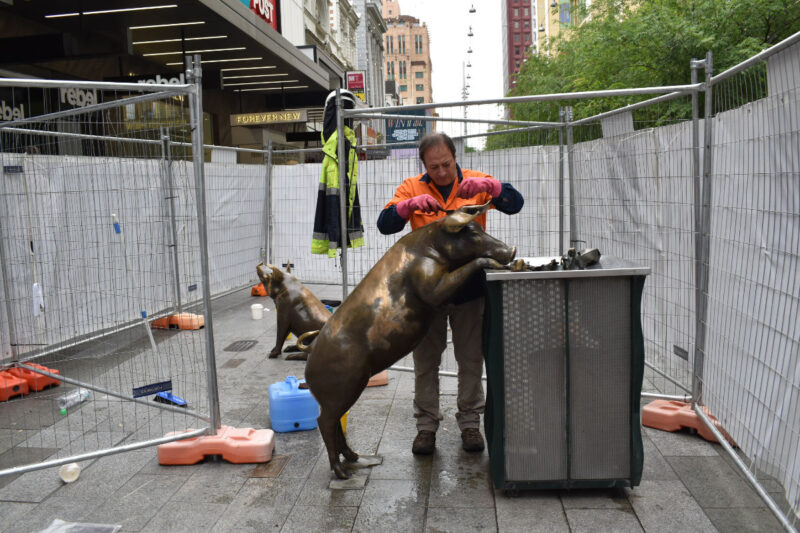
Image: During treatment (DT) – cleaning and graffiti removal by abrasion. Note the bright golden-coloured patch on the flank of the pig showing the extent of the damage.
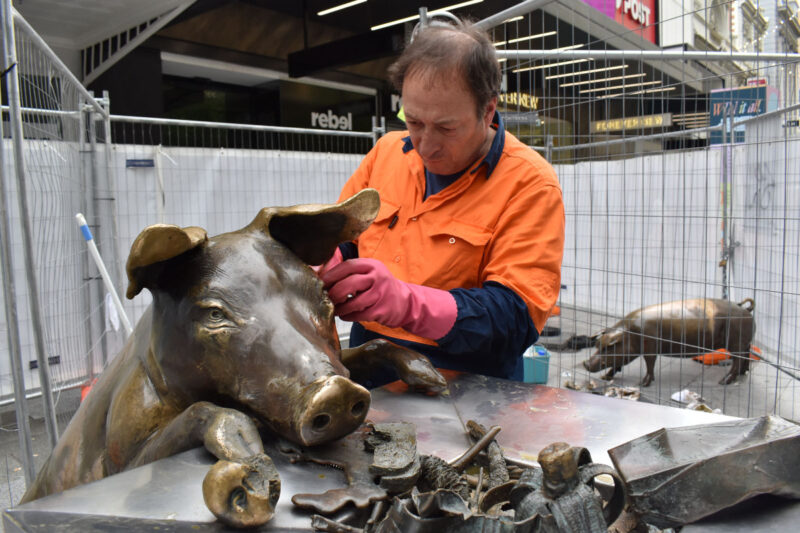
Image: During treatment – cleaning.
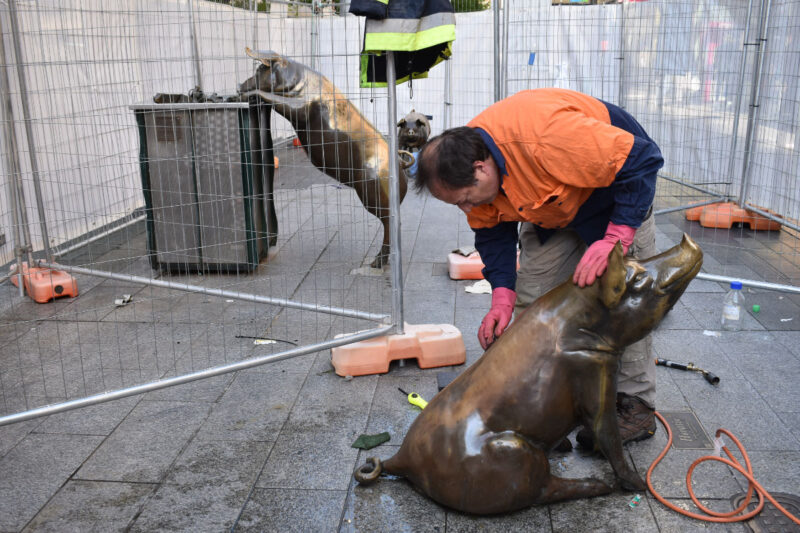
Image: During treatment – artificial patination (colouring) of the damaged areas to match the original patina (colour).
Tasmania
Tasmanian Museum and Art Gallery
We have just installed a rather large retrospective exhibition of works by Tasmanian painter David Keeling called David Keeling: Stranger. The exhibition is the major summer show for TMAG, having been postponed from its original Dark Mofo timeslot of May 2020 due to COVID-19. Conservation involved the whole team: Jenny (paintings conservator), Lisa (conservation technician), Cobus (paper conservator) and Nikki (objects conservator). The show is made up of 70 paintings, more than 60 of which are loans from private lenders. For this reason, Jenny undertook a trip to Melbourne in March to condition report half of the loans. Luckily she made it onto the last Virgin flight back to Tassie prior to the border shutting! Rescheduling the loans and organising freight during the strict lockdown period was quite the feat by the registration team, and we’re pretty excited to see the exhibition installed. Further information is available online
Jenny participated in #AskAConservator Day on Facebook with some great questions on materials, treatments and looking after paintings on display.
We are very excited to welcome Michelle Berry who will be job sharing the Objects Conservator position with Nikki.
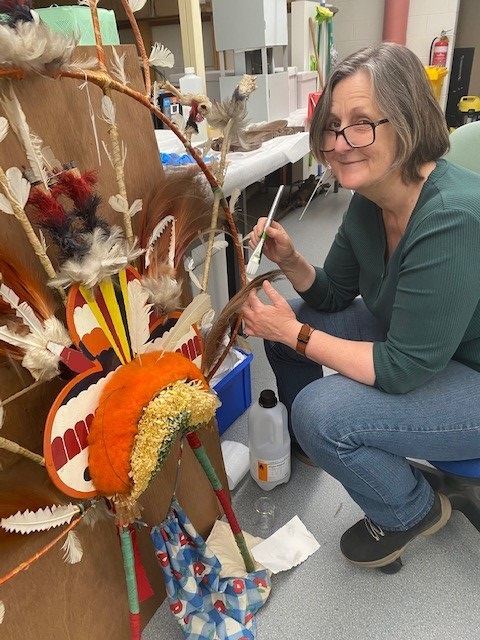
Image: Michelle Berry at work.
Victoria
ICS Melbourne
We have been fortunate to have been able to work through the Victorian lockdown courtesy of being involved in the construction industry as part of the Metro works. We created various distractions to keep us all sane during that time, including a weekly travelogue in which Sydney, Melbourne and Canberra staff shared happy tales of holidays and places they would rather be. We have learnt heaps about each other and been to some truly exotic locations (including outer space!).
Comings and goings
We recently welcomed Yolanda El Khouri as our newest Conservation Technician, and at the end of this working year will sadly farewell Meredith Freeman as Senior Conservation Projects Manager.
National Gallery of Victoria
General news
The National Gallery of Victoria was closed to the public in March, reopened for barely a fortnight and then closed again – since March this has been a nearly nine-month closure! We are excited to be reopening again at NGV Australia on 23 November, and NGV International on 19 December.
In Conservation, we have a new staff member—Adam Mills, as Conservation Art Technician—and Di Knight back on board as a contract textiles conservator.
During the closure and then the transition to on-site work, there has been a considerable increase in cross-departmental work, including Working Groups, and assisting in installing artworks across discipline areas. Many members of the department are also mentors in the AICCM Mentorship Program. The closure has also allowed time for collaboration with Assets & Facilities to undertake important sustainability upgrades including Ionair and LED lights throughout back-of-house spaces.
NGV Conservation department highlights (too many to include!)
Following one of the longest and strictest COVID lockdowns worldwide, the NGV is reopening with over 70 per cent of its 50 galleries installed with new exhibitions including TIWI and Ivan Durrant: Barrier Draw at NGV-A and NGV Triennial 2020 at NGV-I.
Head of Conservation Michael Varcoe-Cocks has been the primary on-site person responsible for overseeing collection care during the closure period. This has included general preventive work such as weekly gallery and storage rounds to check on leaks and pest activity, and ensure that gallery lighting has been switched off. This has also included monitoring of major facility upgrades across both sites. Michael found a little time on the side to carry out cleaning treatment of Arthur Streeton’s The purple noon’s transparent might (1896) in preparation for display at the Art Gallery of New South Wales, as well as completing a few more treatments on Australian Impressionist NGV Collection works.
Coordinating Conservator MaryJo Lelyveld has been attending daily exhibition and installation meetings, and presented at and ‘attended’ the Association of Critical Heritage Studies at UCL London at which there were over 700 presentations. Plenty of time has been spent working closely with senior conservators, Exhibitions and Collections Operations (ECO) and Exhibitions Management to schedule Conservation staff to ensure a safe transition to working back on-site, and to deliver new exhibitions and displays across almost all galleries at both sites in time for the reopenings.
Exhibitions Conservators Catherine Earley and Janelle Borig’s days have been very hectic! From tying up loose ends with Haring Basquiat and KAWS to Triennial and TIWI, Janelle is focused on mounts and installation design for multiple lenders (see image below). As well as Ivan Durrant, with private visits undertaken to condition report loans including into the hills and down to the beach (?!), Janelle did a pre-opening spring-clean of the Destiny Deacon exhibition, as well as continuing to monitor loan spaces at NGV-A using loggers.

Image of Janelle preparing TIWI for installation. Courtesy Conservation department team at the National Gallery of Victoria.
The department’s main focus has been on the preparation of works for Triennial. Condition checking and storage planning of over 80 new acquisition works, and loan preparations by both art technicians and conservators; assessing future loan requests and condition reporting loans departing and examining artworks upon return; and mounting, framing and returning loans to storage have kept all sections busy.
Senior Paper Conservator Ruth Shervington undertook conservation treatment of Siji Krishnan Portrait of my Father, repairing torn pinholes and improving a repair carried out by the artist. Paper Conservator Louise Wilson and Ruth also did a conservation treatment of prints going into the Triennial display. This treatment included stain reduction, repair and retouching (image below).

Image of Louise preparing works for the Triennial. Courtesy Conservation department team at the National Gallery of Victoria.
Conservation Mount-cutter Enrique Tochez-Anderson and Peter Block have been remounting the works of art on paper for Spectrum: An exploration of colour into specific mount colours and new sizes (below left) as well as mounting and framing TIWI works on paper, both NGV Collection items and loans, and mounting and framing John Nixon works on paper for display at NGV-A. On the photography front there was mounting and framing of over 16 photographs for the Triennial, as well as the removal of 30+ exhibition prints from frames post exhibition. Conservator of Photographs Pip Morrison also assisted Textile Conservation with the Faye Toogood project, sewing Velcro to the two tapestries (below right).
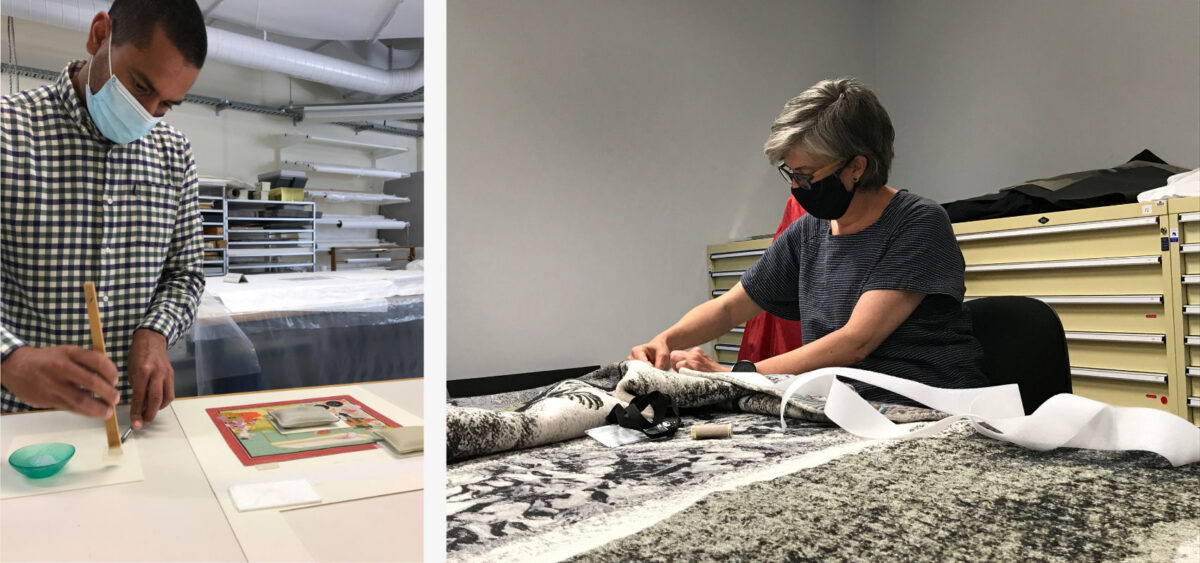
Images of Enrique remounting works for Spectrum and Pip sewing Velcro to a Toogood tapestry. Courtesy Conservation department team at the National Gallery of Victoria.
WFH Textiles Display Specialist Ellen Doyle has been sewing up a storm creating corsets, petticoats and bespoke undergarments for our 19th and 20th-century fashion works. Some of these are going on display in early 2021, but she’s also been working hard to create some stock she can tailor to specific garments once on-site.
Back inside the Gallery the Textiles Studio’s Skye Firth, Ellen Doyle and Di Knight successfully completed the deinstallation of the Collecting Comme exhibition.
Ellen has prepared pieces for the upcoming Spectrum show, creating leg shapes to fill out open-back boots and small toe supports for a pair of 19th-century mauvine shoes.
Textiles Conservator Kate Douglas has prepared pieces for Spectrum including a pair of 18th-century shoes, fine lace and a Peter Tully vest. Kate has cleaned the Gerstberger tapestries for the Triennial and prepared them for display, and also completed conservation and exhibition-preparation works on Tiwi batiks.
This cross-disciplinary dream team of paper, photographs and textiles conservators, Skye, Di, Ruth and Pip, has attached 300 of 1000 feather flowers for a commissioned work by local artist Glenda Nicholls. It will be the largest weaving ever produced by Nicholls and a stunning welcome to the Gallery in its location at the NGV-I waterwall.
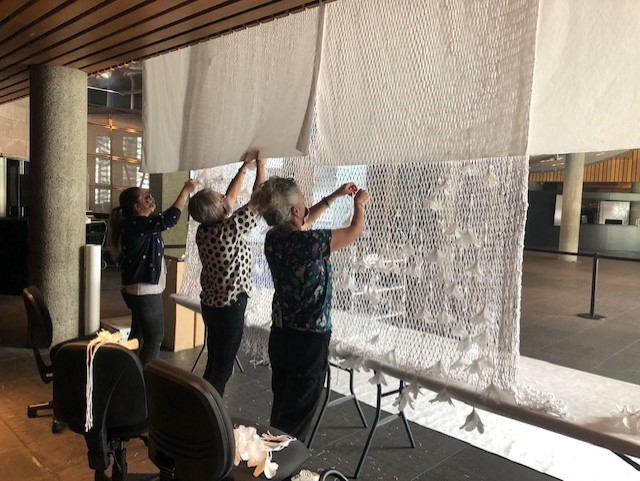
Image of Skye, Di and Ruth attaching flowers to the Glenda Nicholls weaving. Courtesy Conservation department team at the National Gallery of Victoria.
Once back on-site, Objects Conservator Trude Ellingsen has assisted with the installation of a multitude of light works (including a 244-piece neon work by Welsh artist Cerith Wyn Evans) and Di Whittle has overseen Ivan Durrant’s butcher shop installation. Objects Conservation has also been busy with processing incoming works such as a Holden car model (image below), and various sculptures from Cairns Indigenous Art Fair. In the studio the team has also tested and retrofitted light works, including Nicholas Folland’s frozen chandelier (which uses the now obsolete R12 gas) and the cleaning of recently deinstalled Venetian glass.
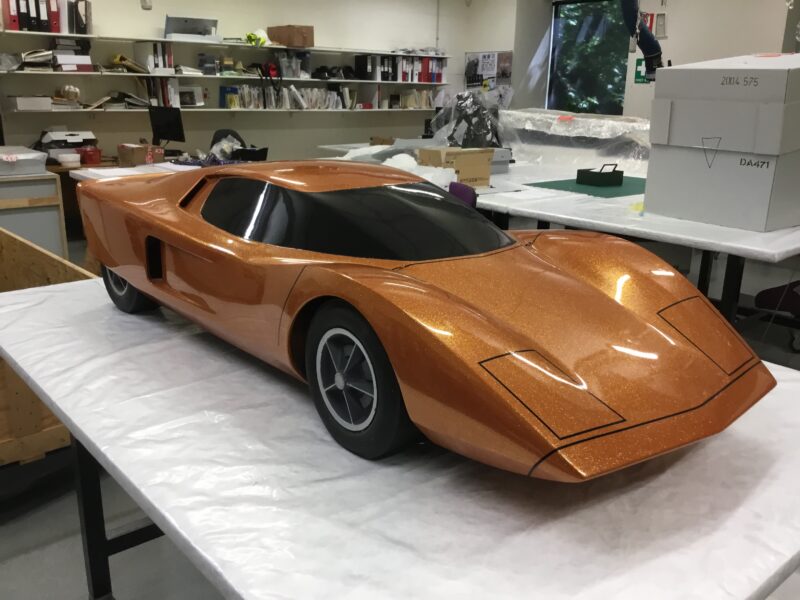
Image of a Holden car model. Courtesy Conservation department team at the National Gallery of Victoria.
Senior Objects Conservator Marika Strohschneider cut the metal footprints for Tomoaki Suzuki sculptures in her home studio for fixing on-site and ended up unconsciously coordinating with one of the sculptures when back in the studio (below right). She also completed the conservation treatment of a Donato Barcaglia marble sculpture for the Fallen Fruit Triennial display (below left).
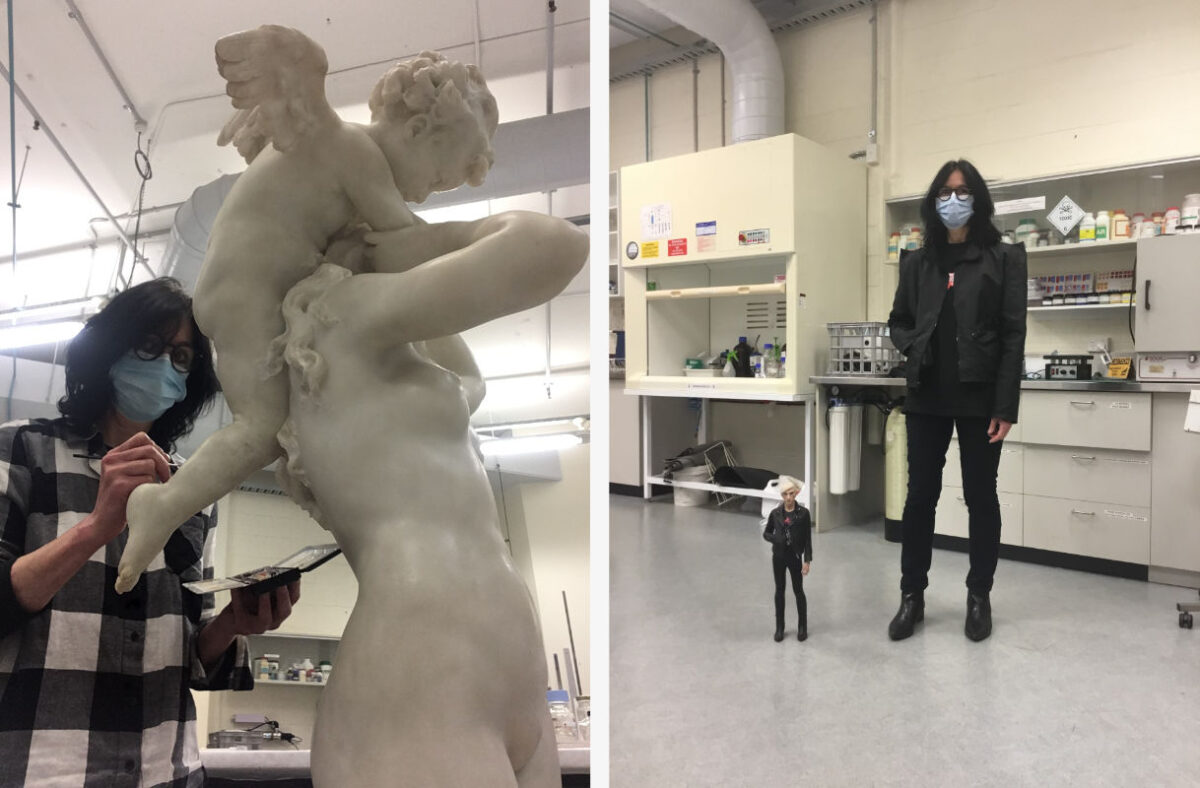
Images: Marika with works by sculptors Donato Barcaglia and Tomoaki Suzuki. Courtesy Conservation department team at the National Gallery of Victoria.
Conservation Art Technician Adam Mills (below) and Senior Conservation Art Technician Eamon O’Toole have been creating mounts for Spectrum, collection bronzes for Fallen Fruit, Alice Potts bioplastic face shields and the Tiwi exhibition.
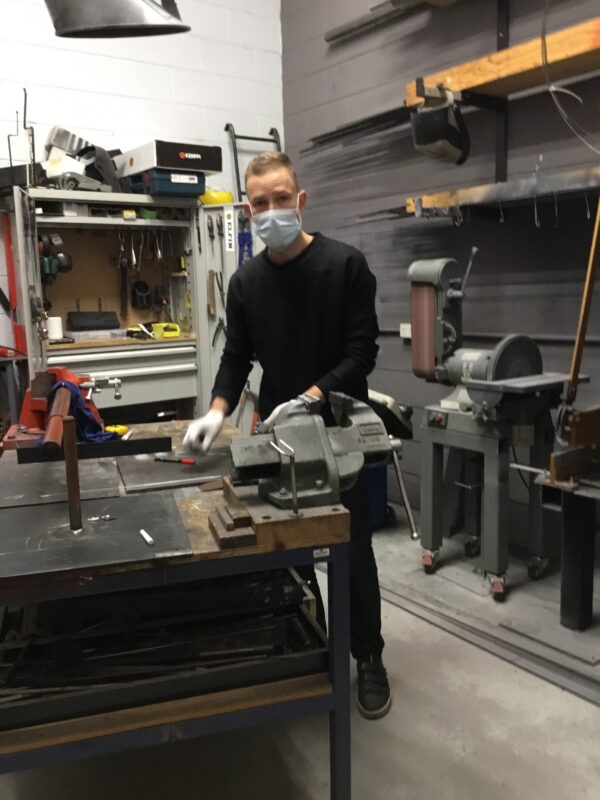
Image: Adam in the welding workshop. Courtesy Conservation department team at the National Gallery of Victoria.
Senior Conservator of Frames and Furniture Holly McGowan-Jackson condition checked many new acquisitions from an interactive lamp comprised of iPhones to resin-encased crustacea and furniture made from copper sulfate crystals. She also assisted with the deinstallation and supervised disassembly of the frame for Murillo The Immaculate Conception. Conservator of Frames and Furniture Suzi Shaw condition checked, prepared and assisted with the installation of Porky Hefer works (below left) as well as assisting with deinstalling and supervising cleaning of glass yams from an outdoor architectural work (below right). We are still working away at our Centre for Frame Research microsite!
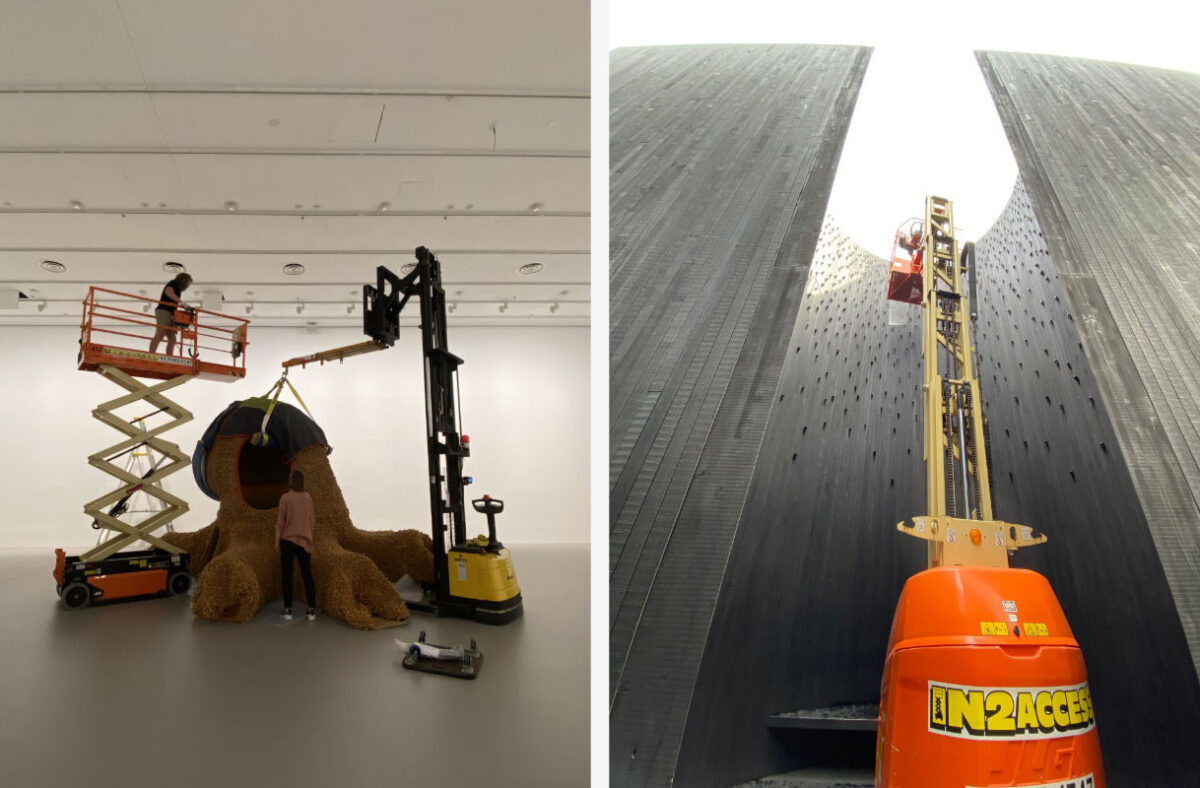
Images: Installing a large Porky Hefer work and deinstalling an outdoor glass work by Yhonnie Scarce. Courtesy Conservation department team at the National Gallery of Victoria.
Frame-maker Jason King finished the Arthur Streeton Spring reproduction frame for loan to AGNSW, and has commenced the gilding of Tom Roberts’ Artist’s Camp frame.
The NGV Painting Conservation team has been busier than ever during the months of Melbourne’s second lockdown. Although we were prevented from going on-site and working directly on paintings, the team spent time providing content for the NGV Conservation Department’s burgeoning outreach presence, both in print and online. Caitlin Breare published an article on her recent treatment of Thomas Clark’s The Upper Falls on the Wannon (1867) in the NGV magazine, and continued her work co-ordinating the conservation entries for the Gallery’s British Art Online project https://www.ngv.vic.gov.au/british-art/behind-the-canvas/. Her recent focus has been on the NGV’s holdings of Pre-Raphaelite painters. Raymonda Rajkowski contributed essays on Dick Watkins https://www.ngv.vic.gov.au/essay/what-is-in-a-title-dick-watkinss-rain-in-west-pymble/ and Hans Heysen https://www.ngv.vic.gov.au/essay/bringing-to-light-hans-heysens-sunshine-and-shadow/, along with a social media feature on the conservation of bark paintings. Raye Collins has written technical essays on paintings by Salvador Dali, Francoise Gilot and Dora Maar for the upcoming French Art Online project. Carl Villis has written an article about the MS3 varnish project collaboration for the UK journal The Picture Restorer, and has collaborated with Deborah Lau and her CSIRO colleagues for another article on the physical, chemical, aging and handling properties of MS3 for the Journal of the American Institute for Conservation.
Since the lockdown restrictions have eased the entire paintings team has been on the floor assisting with the reinstallation of the permanent collection and the installation of major new exhibitions such as TIWI and the NGV Triennial, as well as new acquisitions.
Events, outreach and online initiatives
We are now moving back to on-site work and exhibitions preparation, so the events, outreach and online initiatives have slowed down (a little). Jessica continues to coordinate the department’s contributions to outreach and digital engagement programs including: NGV Channel, Instagram, e-newsletters and NGV magazine, as well as contributing to NGV Online events and media pieces as appropriate.
Recent online events hosted by NGV conservators include Conserving and Displaying Fashion at the NGV, with Skye Firth and Ellen Doyle, and Albrecht Dürer watermarks at the NGV with Ruth Shervington and Louise Wilson.
Check out @ngvmelbourne Instagram for rolling Conservation Department updates, including previous stories archived under the ‘Conservation’ highlights.
We also joined in on the International Ask A Conservator Day action, with short responses filmed from eight of our team shared on social media. We had many quirky questions we didn’t get a chance to answer though.
In the November-December edition of the NGV magazine our department made unique contributions to explore including:
- ‘Conservation 101: Collecting environments’. This conservation feature includes essays by MaryJo Lelyveld, Di Whittle, Suzi Shaw, Ruth Shervington and Pip Morrison. There is also a collection spotlight on John Wolseley at the bottom of the online magazine webpage by Ruth.
- ‘Collaborating to conserve’ by Carl Villis. There is also a multimedia piece, narrated by Jessica Lehmann.
- ‘Collection Care in COVID times’ by Michael Varcoe-Cocks
- ‘Rehousing the Andree Harkness Gift’ by Enrique Tochez-Anderson
- ‘Conserving Streeton’s iconic Australian landscape’ by Michael Varcoe-Cocks and Jessica Lehmann.
MS3 resin. What’s the invisible Australian goo on some of the world’s most famous art? Read about the MS3 resin in The Age: https://www.theage.com.au/culture/art-and-design/the-invisible-australian-goo-on-some-of-the-world-s-most-famous-art-20200902-p55rnq.html . Congratulations to the Paintings team and CSIRO – they were awarded winner of the category in which they were nominated! https://techtransfer.org.au/csiro-scoops-the-pool-at-prestigious-research-commercialisation-awards/
There have also been plenty of lectures delivered for Melbourne University by almost all sections during the past few months, as well as online events for NGV benefactors and conservation supporters.
Western Australia
Heritage Conservation Solutions
Recent events in the City of Belmont, which borders the Swan River and the famous racetracks and the Perth airport, included the opening of the Hub. This is a new library and museum centre, which incorporates a conservation laboratory in which work can be conducted on the heritage collections that are typical of a community-based museum. Recently some damage occurred to one of the smaller jarrah wooden road blocks, which had partially collapsed during relocation from its storage environment, and so with the aid of some 3 wt% PVB in ethanol Ian MacLeod reattached the outer fragments and once they have off-gassed the ethanol an infill will be completed using local debris field materials.
During discussions with the new archivist the subject of acetic acid off-gassing from old films and tapes came up. After a 36-hour test with acetate indicator strips the colour change, corresponding to known concentrations of CH3COOH, was matched with surface pH readings and the results are awaiting peer review but it looks as though the surface pH readings, along with the colour chart, enable the different sensitivities of film and magnetic tape to be determined. Data analysis showed a lovely logarithmic dependence of the colour on the concentration of acetic acid. Surface pH values on acetate film were as low as 4.05 and one nitrate film was around 3.86, so it was packed off to the digitising facility at an external laboratory. Great work Bridget and Tamara.
Earlier in winter the remains of several hundred people were exhumed from the former East Perth Cemeteries by Terra Rosa Archaeology and Denmark River Textile Conservation Studio (Rinske Car) was successful in gaining the contract to conserve a working man’s jacket and to separate it from the bones of the torso, to which it was very firmly attached. Using Sigma Aldrich’s Alcalase enzyme solutions proved to be very effective at mobilising the decayed proteinaceous materials from the decomposed body. One of the biggest challenges is the mass of roots that have grown up through the jarrah coffin base and down through the collapsed lid into the bones and textiles. Once the work has been finalised a paper will be prepared so that other conservators can learn from the experience. The use of aqueous glycerol as a humectant proved to be very effective at relaxing the fibres of the jacket, allowing frozen folds to be uncurled. A series of surface pH and chloride measurements were done during all stages of the treatment and demonstrated the most effective treatment methods. Rinske Car was assisted in this work by Ian MacLeod. Prior to commencing the work, a service was conducted in the crypt of St George’s cathedral by Bishop David Murray and the conservators assisted with the body. This procedure ensured that his spirit was free to leave the body.